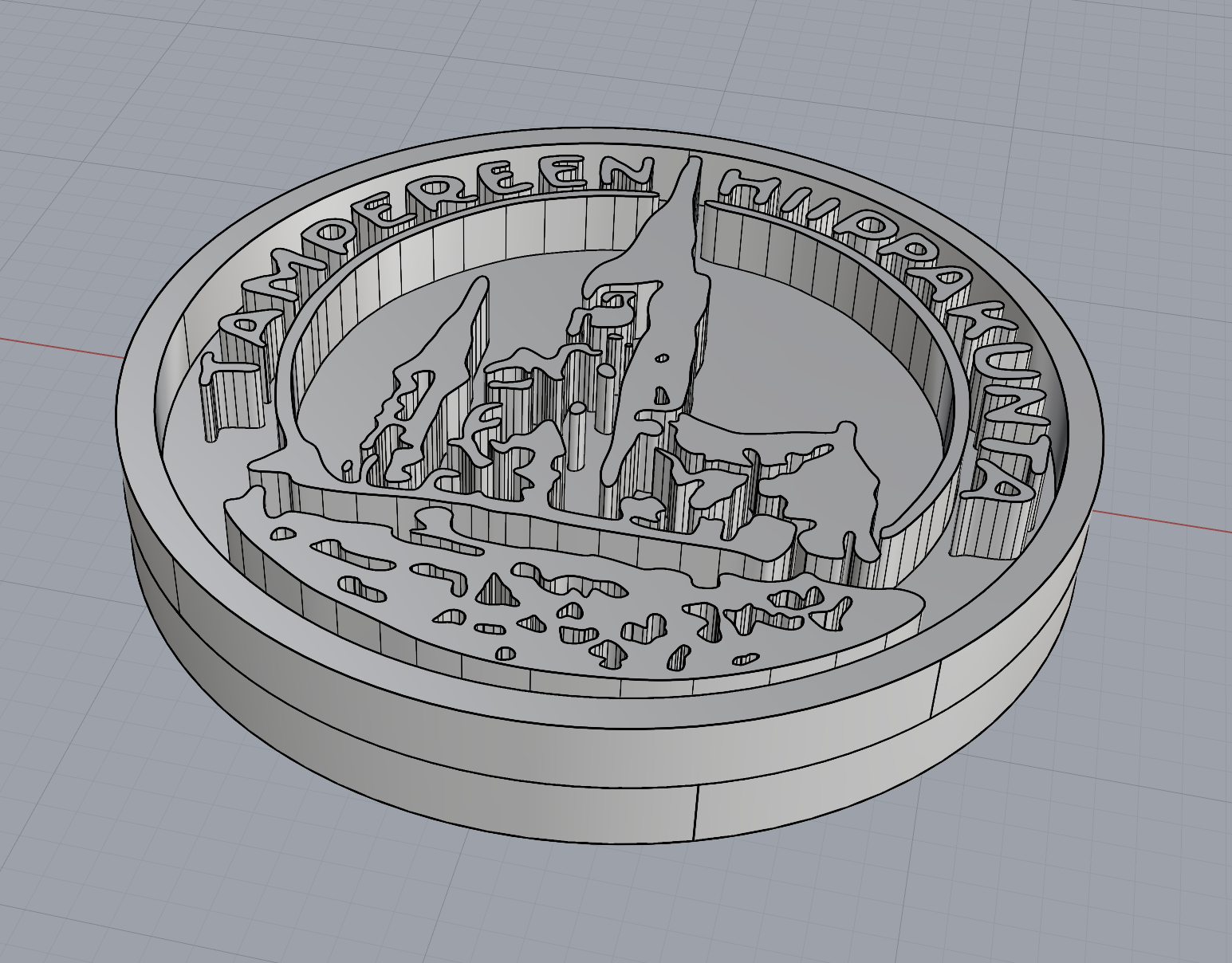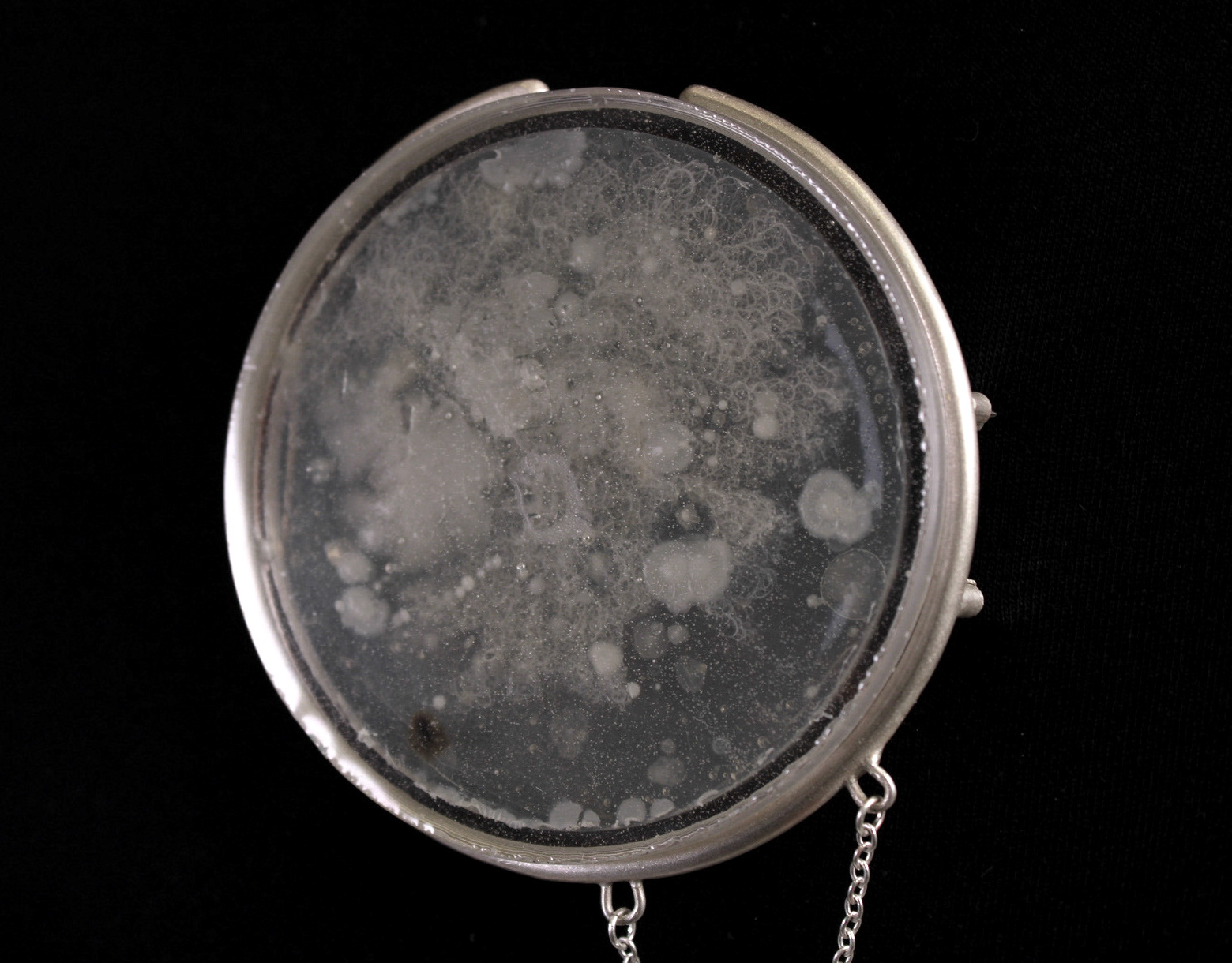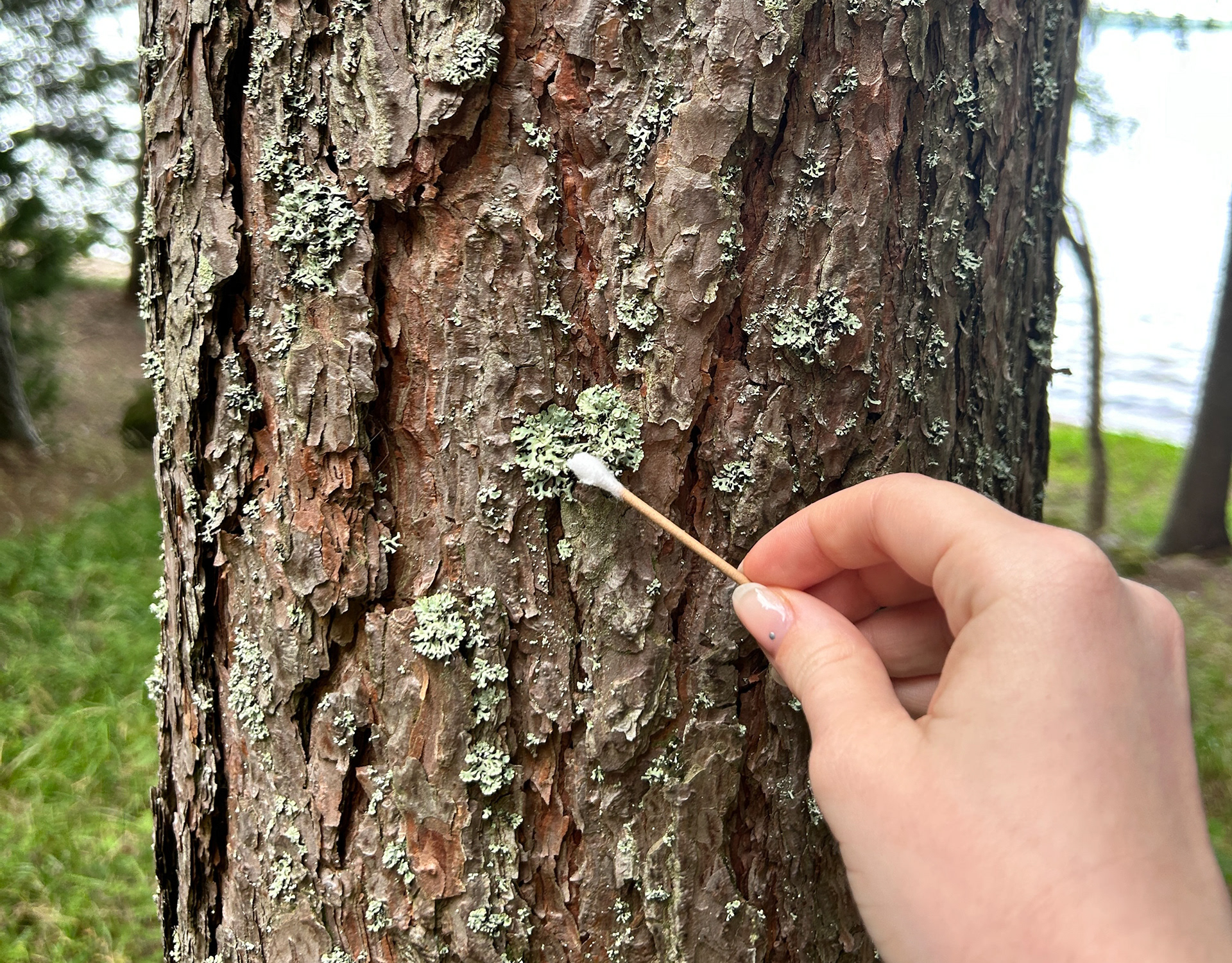Connecting with a Microbiologist
Zoie Aiken is a microbiologist at the MRI who specialises in antibiotics and infections and is also a friend of CJ. I've been in contact with her to arrange a meeting to discuss my project. Although CJ has already explained my project to her, I would like to speak with her directly to explore where my project could take me, and whether she knows of any labs that could assist with growing bacteria in a safe and controlled environment.
As well as that, I hope to find labs that could help me get high-resolution images of my cultures, rather than relying on pictures through a microscope, which I used previously in UC2 with different cells.
Although I haven't spoken with Zoie yet, this connection has significant potential to support my work during Synthesis and Resolution.
Funding
Flash Fund
At the start of the beta project, I applied for the MMU Flash Fund for the second time, where I was awarded £250 again. Through this, I have become familiar with how to apply for grants and will carry this forward in the future when applying for any other grants or competitions.
It has also given me the opportunity to think about what I want to do after graduation and explore the idea of creating my own jewellery business. Could I still be using the bacteria to create these personalised biological components in jewellery, and if so, how am I going to market this?
Competitions
Goldsmiths
Every year Goldsmiths' Craft and Design Council hold competitions. There are 2 main categories, 2D work and 3D work, with 1 subcategory for 2D, and 3 subcategories for 3D. You can be at any stage in your career to apply, including students. While my work is not up to the standard of Goldsmiths yet, it is useful to start looking at the different categories and the standard of work that is successfully shortlisted.
I had a look through the different categories and have picked which categories I feel like my work would best fit, if I continue with bacteria jewellery.



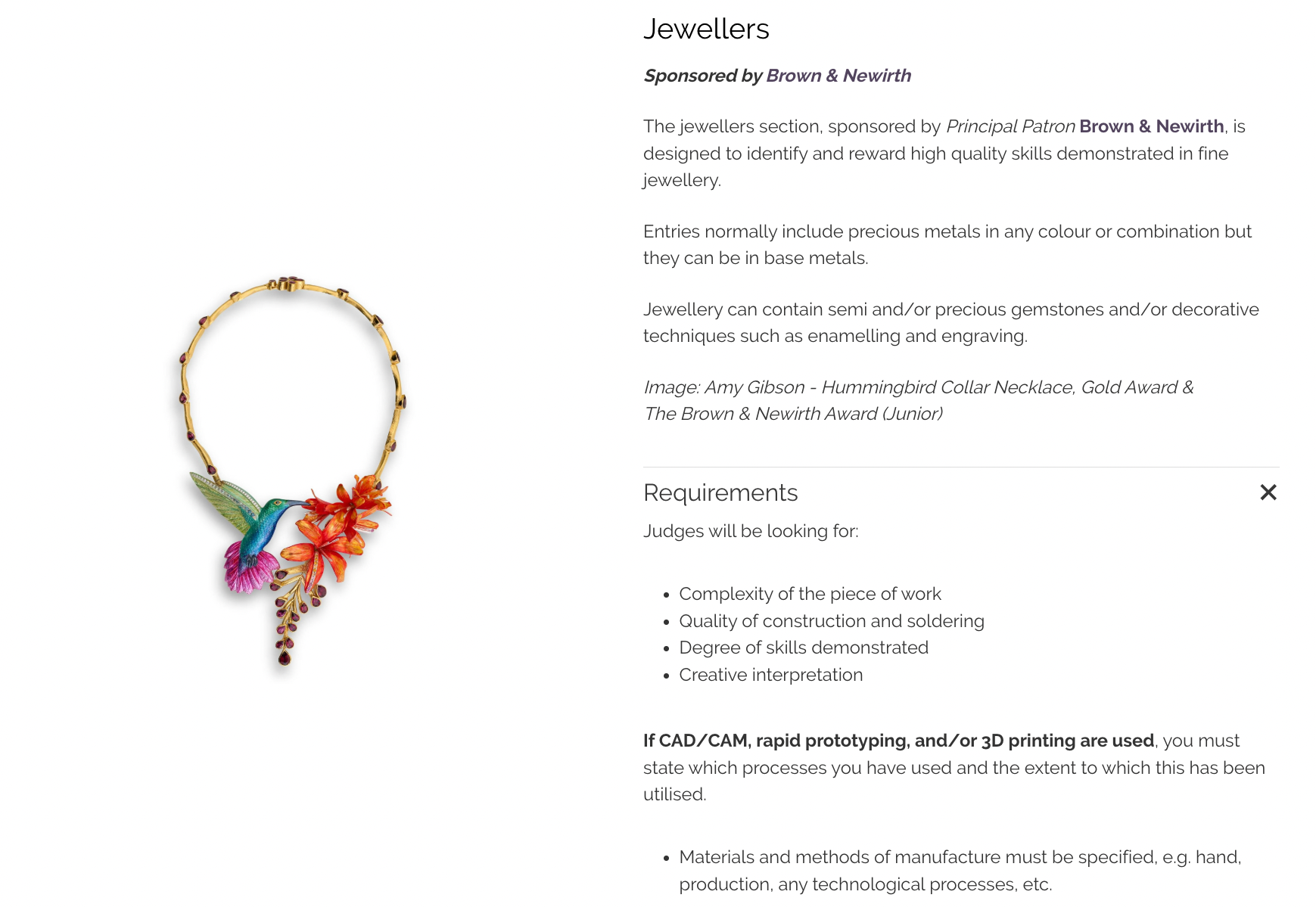
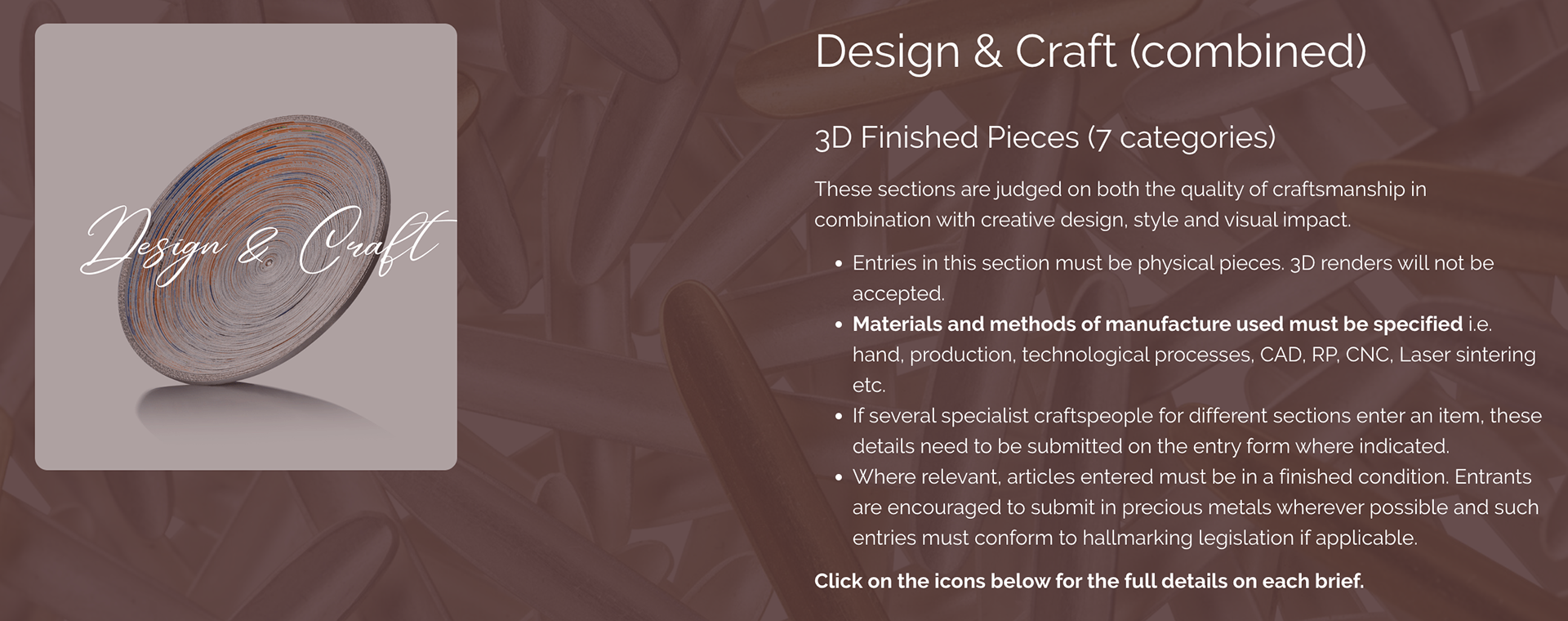

I personally feel as if the Conceptual Jewellery category is the most interesting category that I came across. If I continue to refine my bacteria work alongside my making skills, specifically with precious materials, then there could be potential to apply for something like this.
Vertical Gallery
Towards the end of Unit X, we had a talk from Kate Egan and Victoria Dahl. They briefly explained the Vertical Gallery Commission process, whereby you can receive funding from the university to create pieces for the Lowry Building. These pieces can be experimental and on a completely different scale than what you might be making at the moment, which makes it an exciting opportunity. I had not previously thought about applying for the Vertical Gallery as I use bacteria in my work, however, they explained that they make their best efforts to be able to include as much as possible, and will help come up with solutions if something is not possible. I think that this could be a really exciting opportunity to apply for, and while I do not currently have an idea, I really like the idea of being able to showcase bacteria in a new light to more people.
There is also the opportunity to collaborate within the vertical gallery, whether this be with another student or external. I think that it could be really interesting to potentially collaborate with someone else and potentially moving the bacteria work into other mediums.
Open Calls
WOW Effect Open Call
As part of looking for external opportunities, I decided to look at the WOW Effect open call as part of the Legnica Jewellery Festival SILVER 2025. My idea was to submit my Unit X final piece to this competition.
However, there may be a couple of limiting factors with this.
The date that the piece has to be in Poland by is the 20th January 2025, which means that I would need to post my piece at least a week before. With marking for Unit X being over Christmas, I may have to check when I am able to remove my piece from the studio.
As well as that, I do not think that I would be able to post my bacteria samples, even when covered in resin. I do not know how the air pressure from air travel might affect the resin and the agar. Because of this, I feel that using a different material instead of bacteria may be more appropriate.
This could be my 3D scanning and casting of the plate idea, or the silicone mould idea.
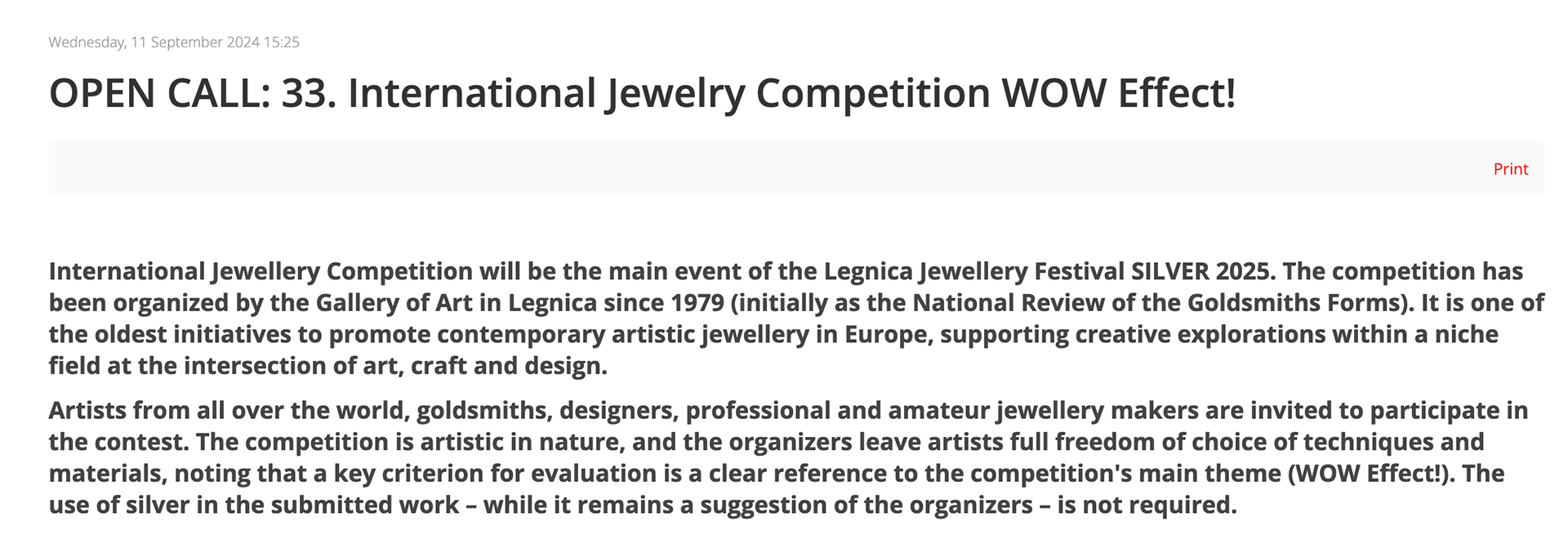
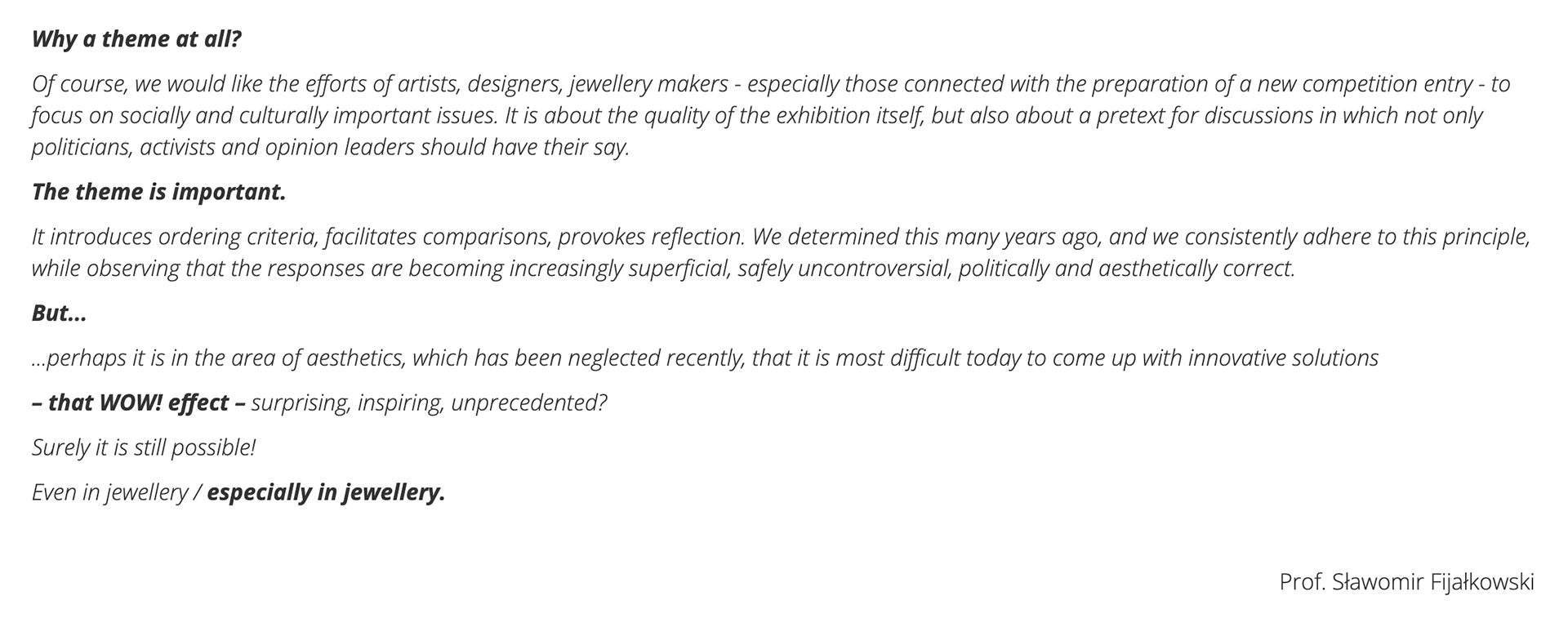
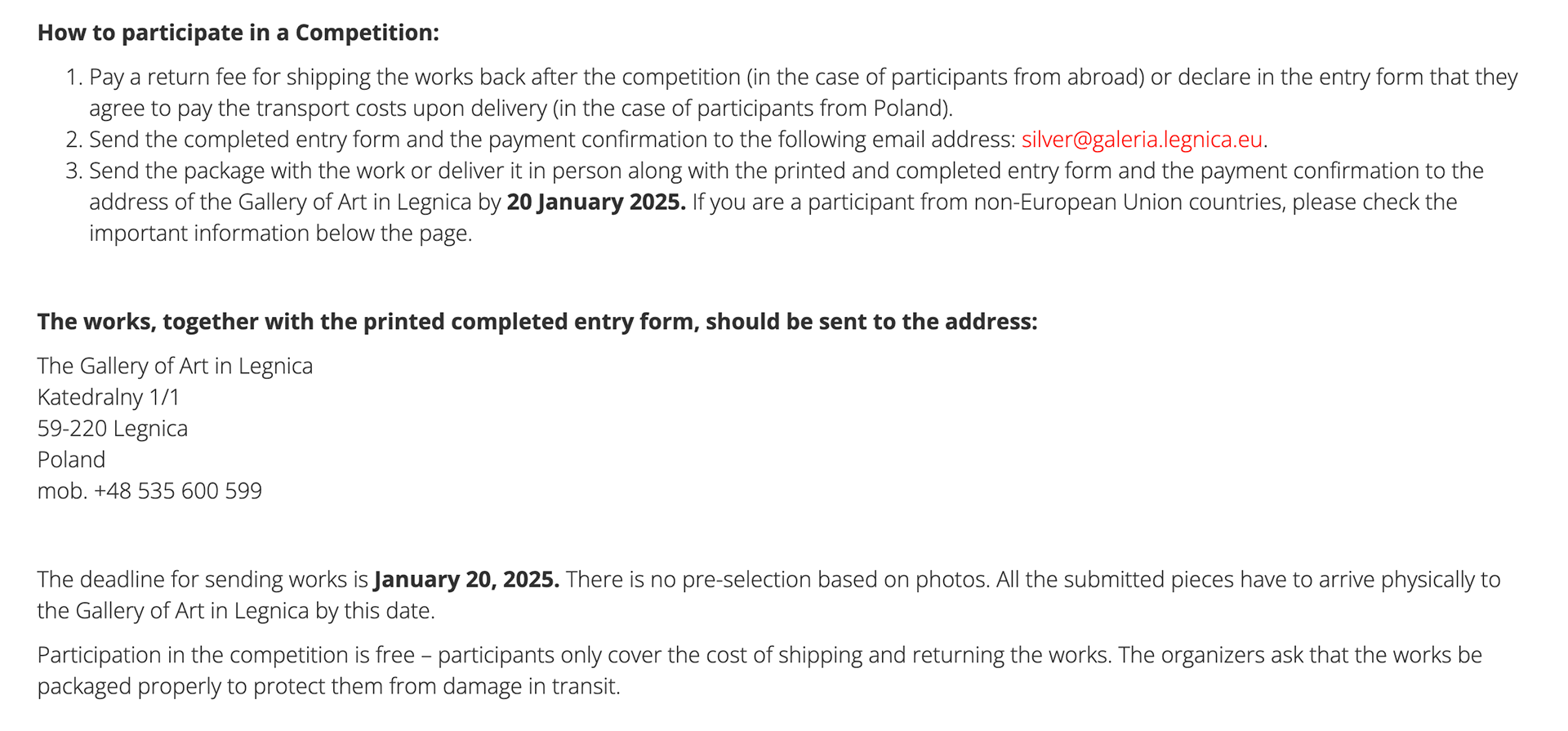


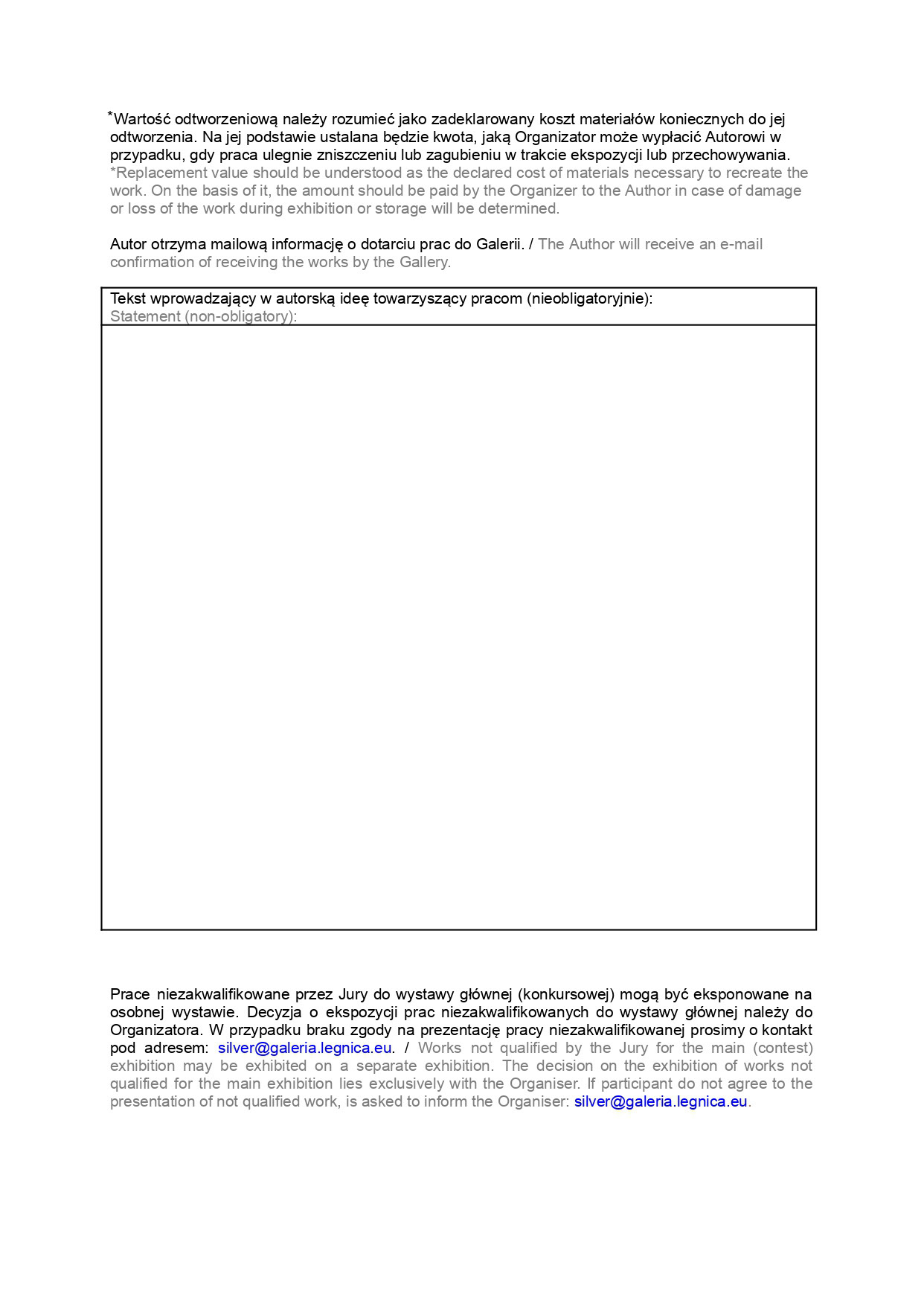

Chaos & Control - Munich Jewellery Week 2025
Precious Collective is organising an exhibition called Chaos & Control during Munich Jewellery Week 2025. This open call is looking for submissions that explore the interplay of chaos and control, inviting artists to reflect on these contrasting concepts through their jewellery creations.
Artists are encouraged to submit pieces that interpret the theme in any medium or technique. Both emerging and established artists are welcome to participate, meaning that this will introduce a diverse showcase of perspectives and creativity.
While I do not think that my work is up to the standard of Precious Collective, I do think that if I continue within an art jewellery route using bacteria, then an exhibition like this could be appropriate. I especially think that this theme would work well for my bacteria work, the chaos of letting this bacteria grow paired with the control of preserving it within resin and the silver bezels holding the piece together.
Residencies
University for the Creative Arts
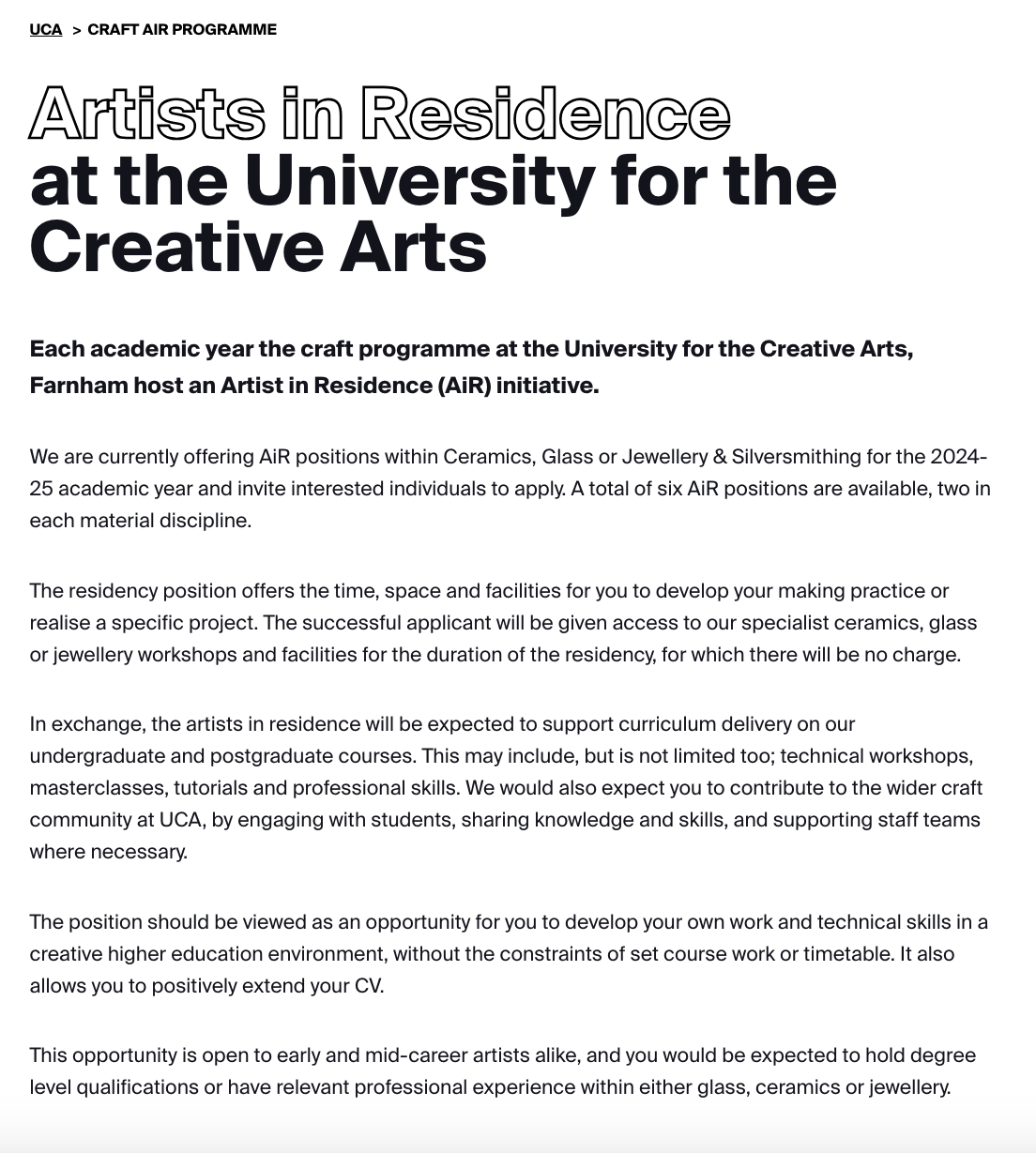

Each year UCA in Farnham hosts a residency for artists to develop their practice using the facilities on campus. What I find most interesting about this residency, is that in exchange for using the facilities, you are expected to help support the teaching of the curriculum on both the undergrad and post-grad courses. For this current academic year, the AiR (Artist in Residence) program was for craft, meaning that the teaching was for both the Jewellery/Silversmithing BA, as well as a Jewellery MA.
The idea of working in education is something that I have thought about, and opportunities like this could be valuable to both my practice and my career. The facilities at UCA are incredible, with huge jewellery workshops as well as excellent CAD facilities, which is something I am starting to explore and combine in my practice.
Residencies like this are highly competitive, with this particular one only having two spaces available for jewellers. If I choose to apply to an opportunity like this in the future, it will be essential for my work to be of an exceptional standard, demonstrating both technical expertise and skills that I can contribute to teaching. I would also need to make sure that the project I propose is engaging, and something that would stand out on an application. It would need to capture the interests of others and make people interested in how it could be explored. While I think that there is so much I can do with my bacteria project, I would need to have a very clear idea of what paths I would like to explore.
Employment
Support Technician - 3D Jewellery
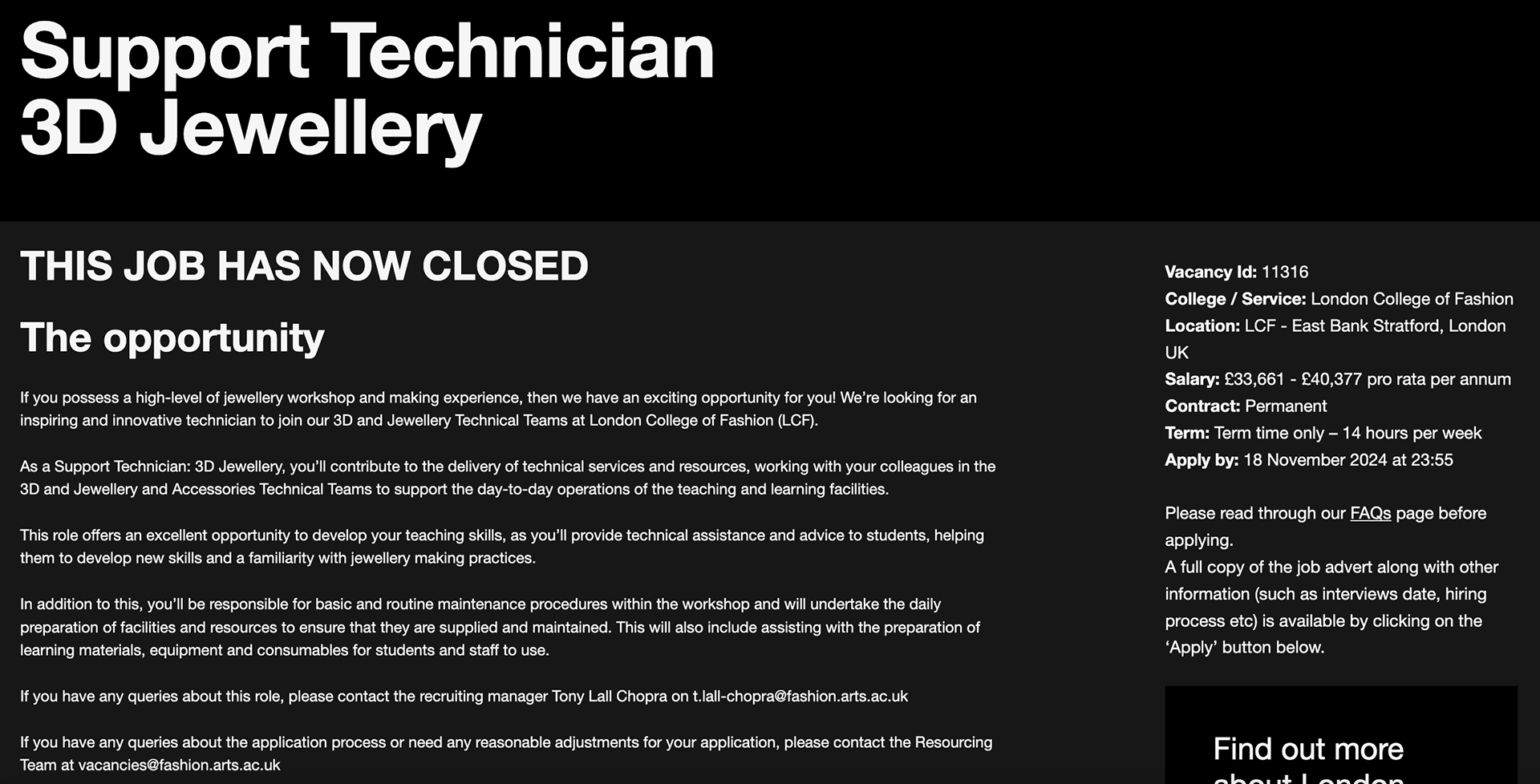
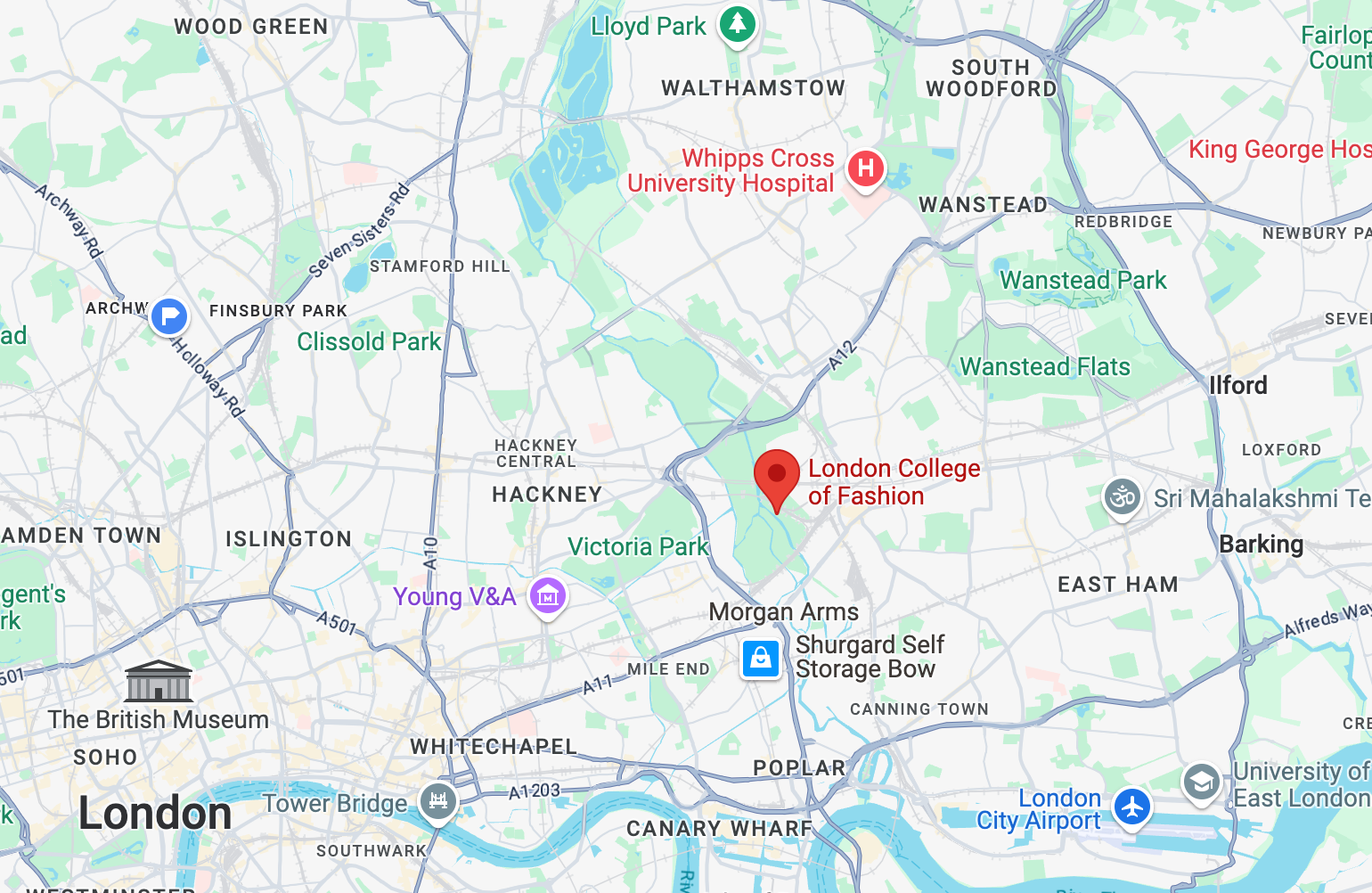
Knowing that I would need a stable income after graduating, I began researching metal and jewellery technician roles to understand the opportunities available. While I am not applying for these positions yet, I felt it would be useful to look at the locations where these jobs are commonly found. Unsurprisingly, London was one of the most popular areas for such roles. Although a position at London College of Fashion had recently closed, I read the job description to look into the skills and qualifications typically required for these applications.
Many technician roles also include teaching responsibilities, something I have shown interest in. As a recent graduate, I believe my experience could be valuable, as I understand how challenging it can be to learn new techniques while keeping on top of other course commitments.
Serpentine Jewels
As mentioned in 'Beta Project - Research', I was offered an internship with Ali Galgano after graduating. While this will be an unpaid internship, it will be valuable to my CV, working one-on-one with clients to design bespoke jewellery. My understanding of materials and mechanisms will be useful here, as well as the understanding of CAD that I am currently working on. This has the potential to lead me into a career working with clients, as well as creating a core 'ready to wear' collection.
Courses
Goldsmiths
Goldsmiths run a variety of courses, ranging from in-person, to online, as well as short courses, to longer ones. Each course is delivered by professionals from their retrospective fields. Some of these courses are technical, providing support in different stone setting techniques, enamelling, surface textures etc., while many are also about running a business effectively. I have looked at the different courses they offer, and have chosen some that have sparked my interest.

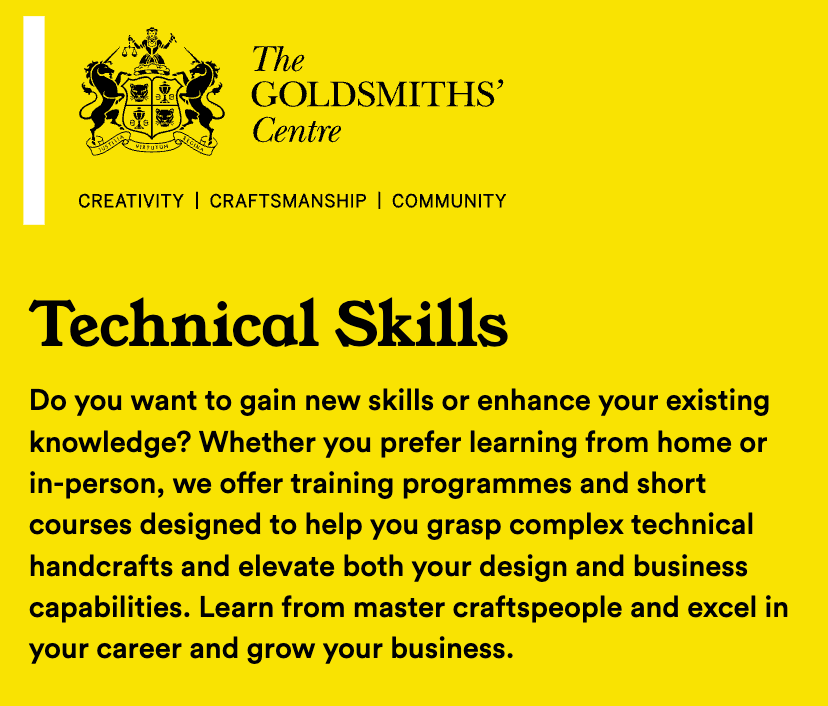
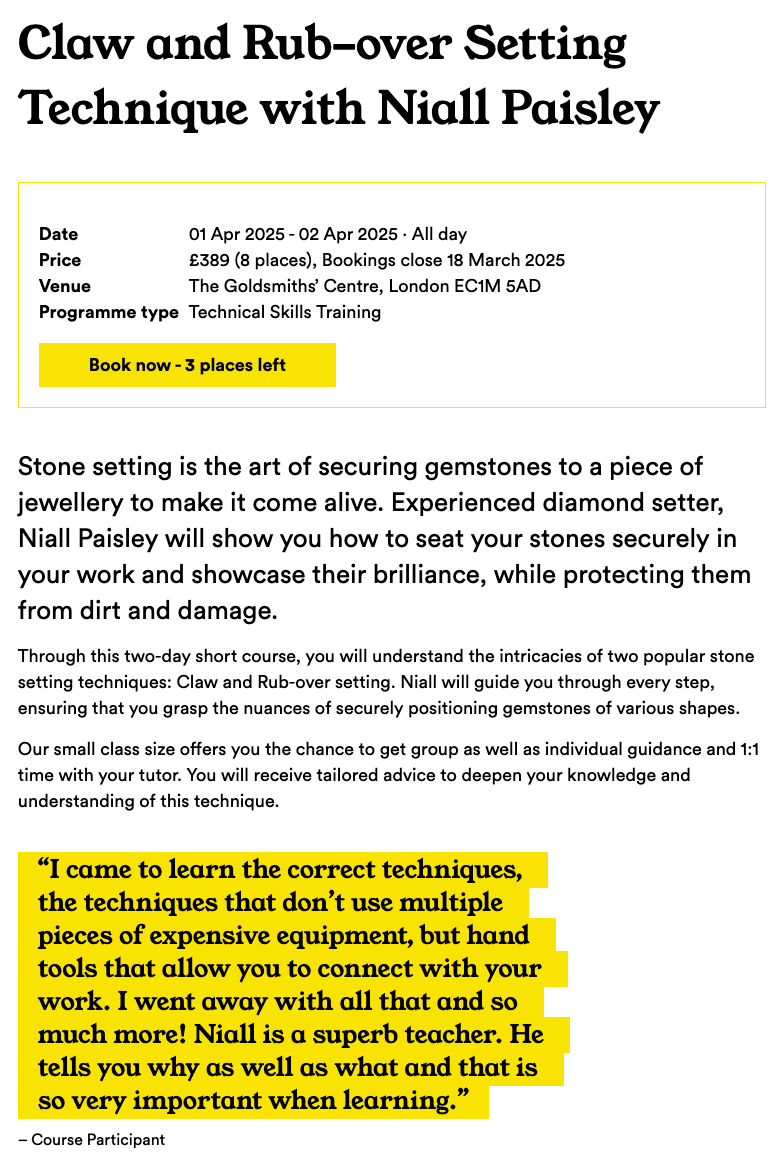
The short courses that have particularly caught my interest are their CAD introduction courses. While the longer, more intense, course runs during term time, the online short course is only for a couple of hours and costs only £19. I think that doing this course will help me understand the jewellery features of Rhino, something I have not used yet, while also helping me explore different 3D CAD software, as I have previously only used Rhino3D, Fusion360, and a very small amount of Blender.
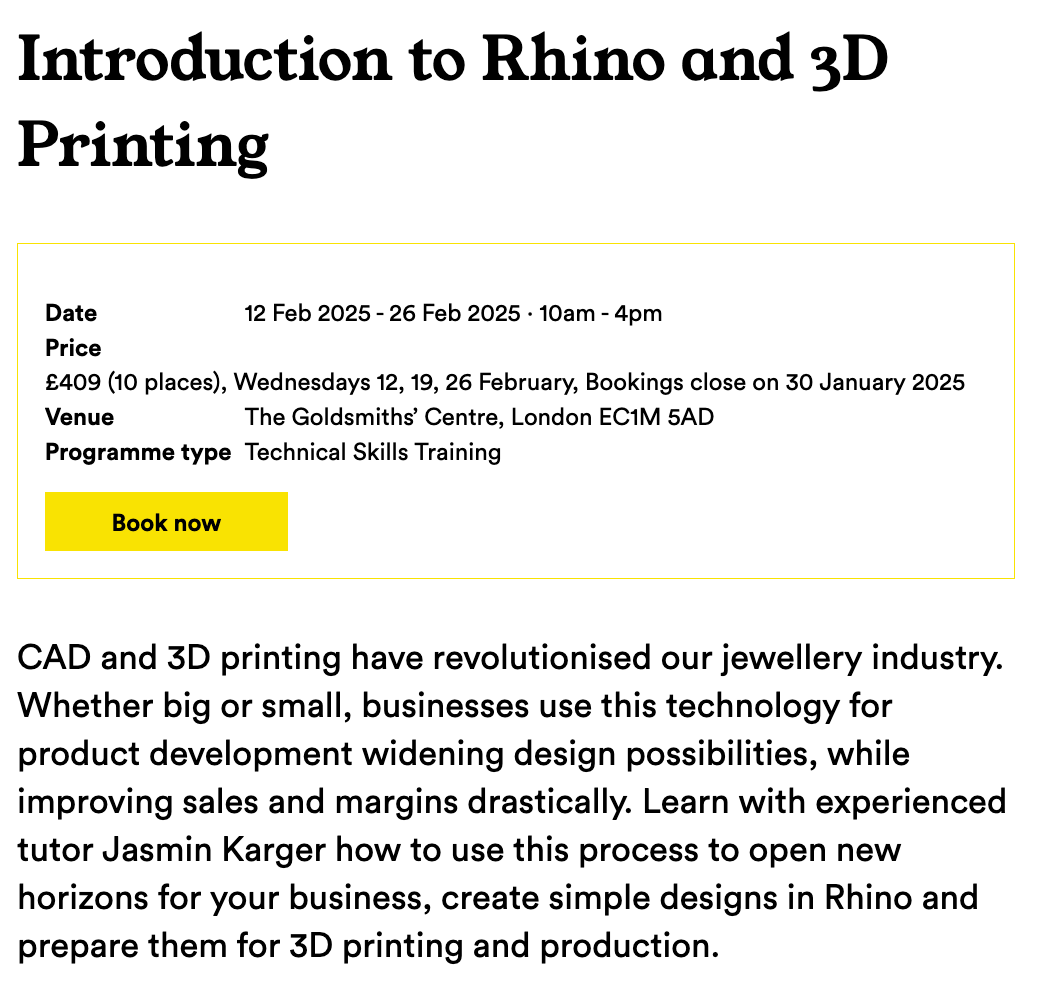
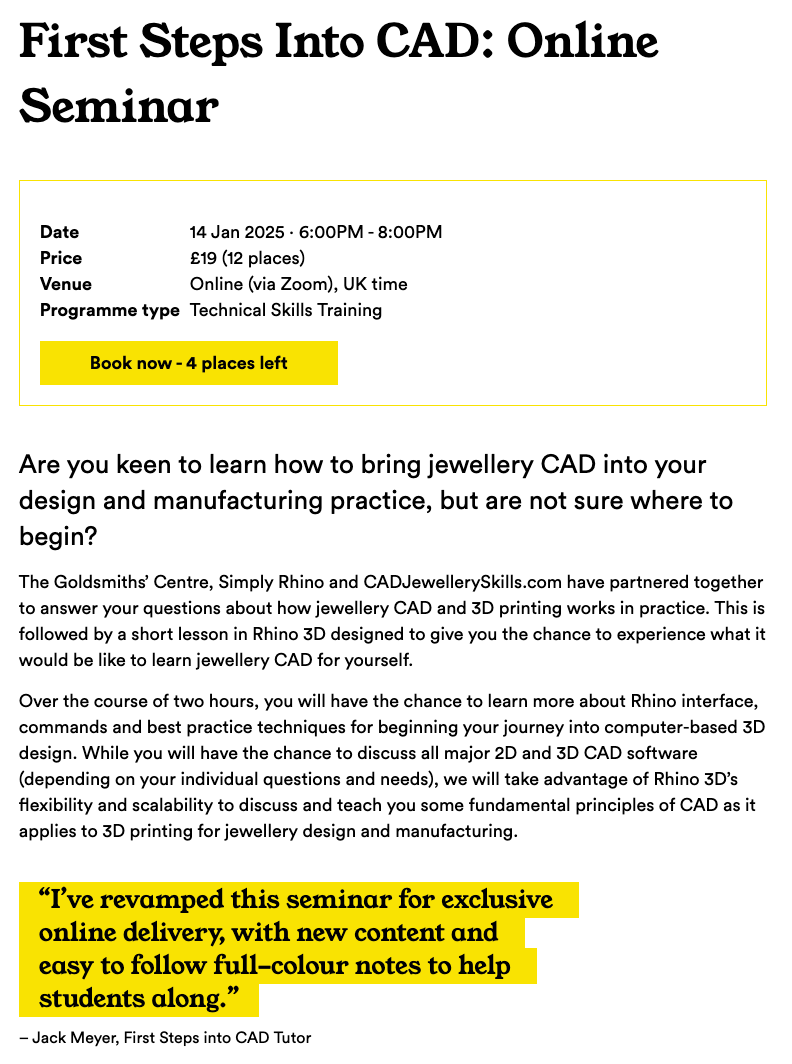
GNCCF
The Brief
The theme of our Great Northern Contemporary Craft Fair show was 'It's Got Legs,' symbolising the idea that something has great potential. The event was designed as a sample show, where each student from Craft and Textiles would present 1-2 samples from their current projects. The aim was to highlight the potential of these projects, with the samples ideally showcasing either a technical skill or the narrative aspect of their work.
We had only 12 days from being given the brief until the set-up, and 15 days until the private viewing, making this a rather short timescale.
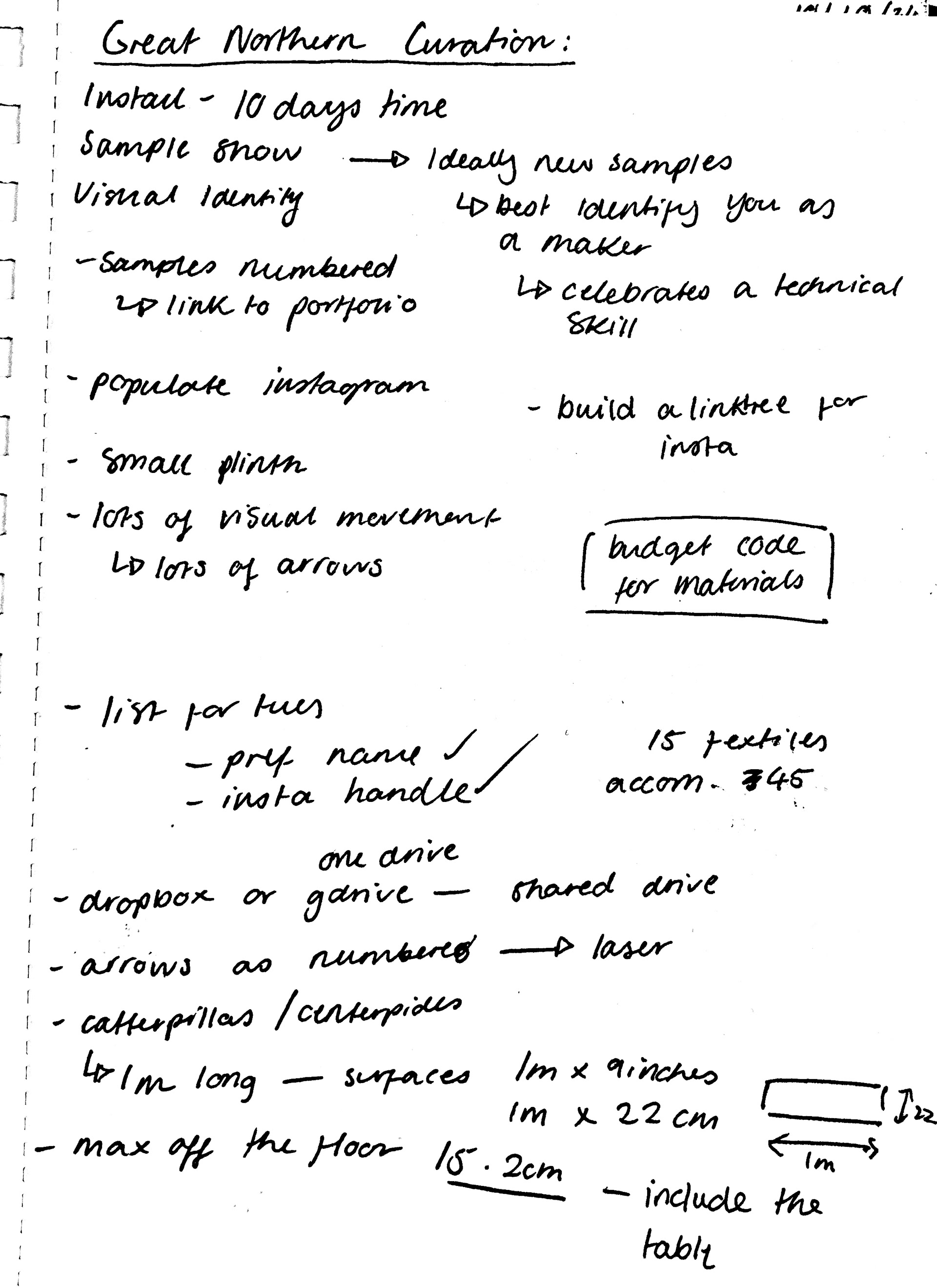

The Space
The space that we had been allocated by GNCCF was part of the old superintendent's flat, a 3.96m x 4.5m room.
Since this building is Grade II listed since 1983, it hasn't been renovated or maintained in the same way as other historical buildings. As a result, the room featured 'charming' signs of age, such as exposed brick, worn wallpaper, and even some missing sections of walls and ceilings. These elements added character and a unique individuality to the space.
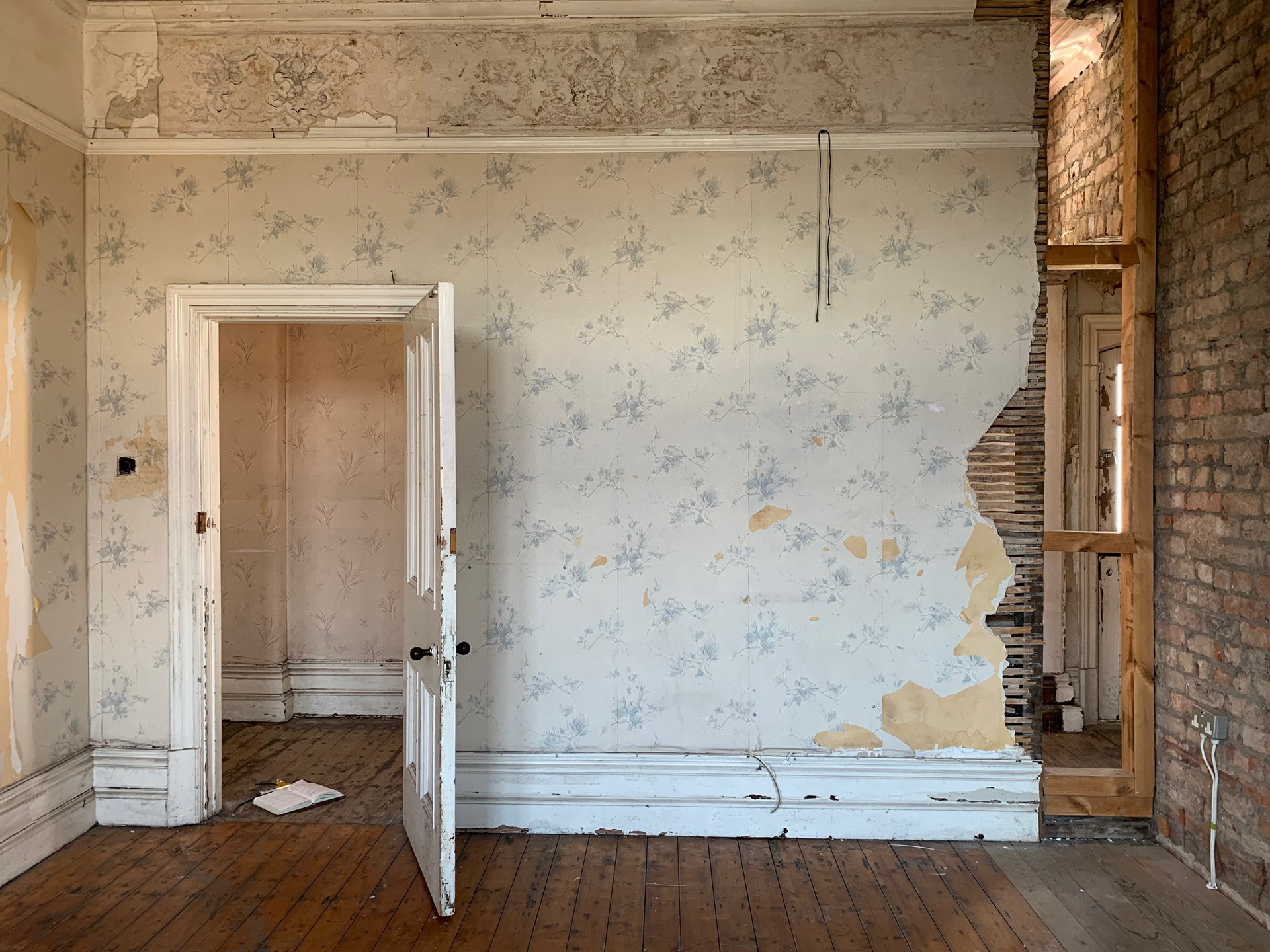
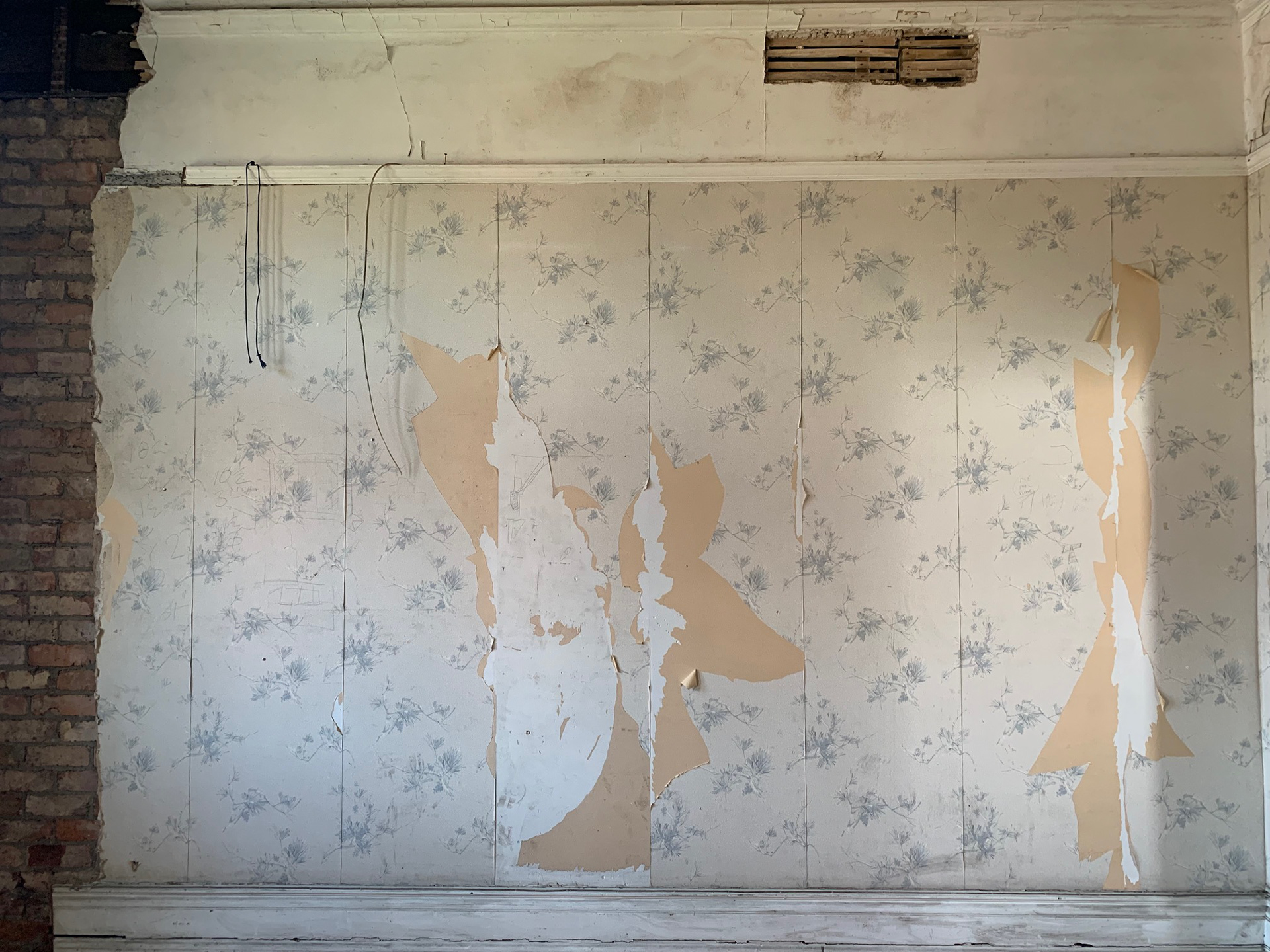


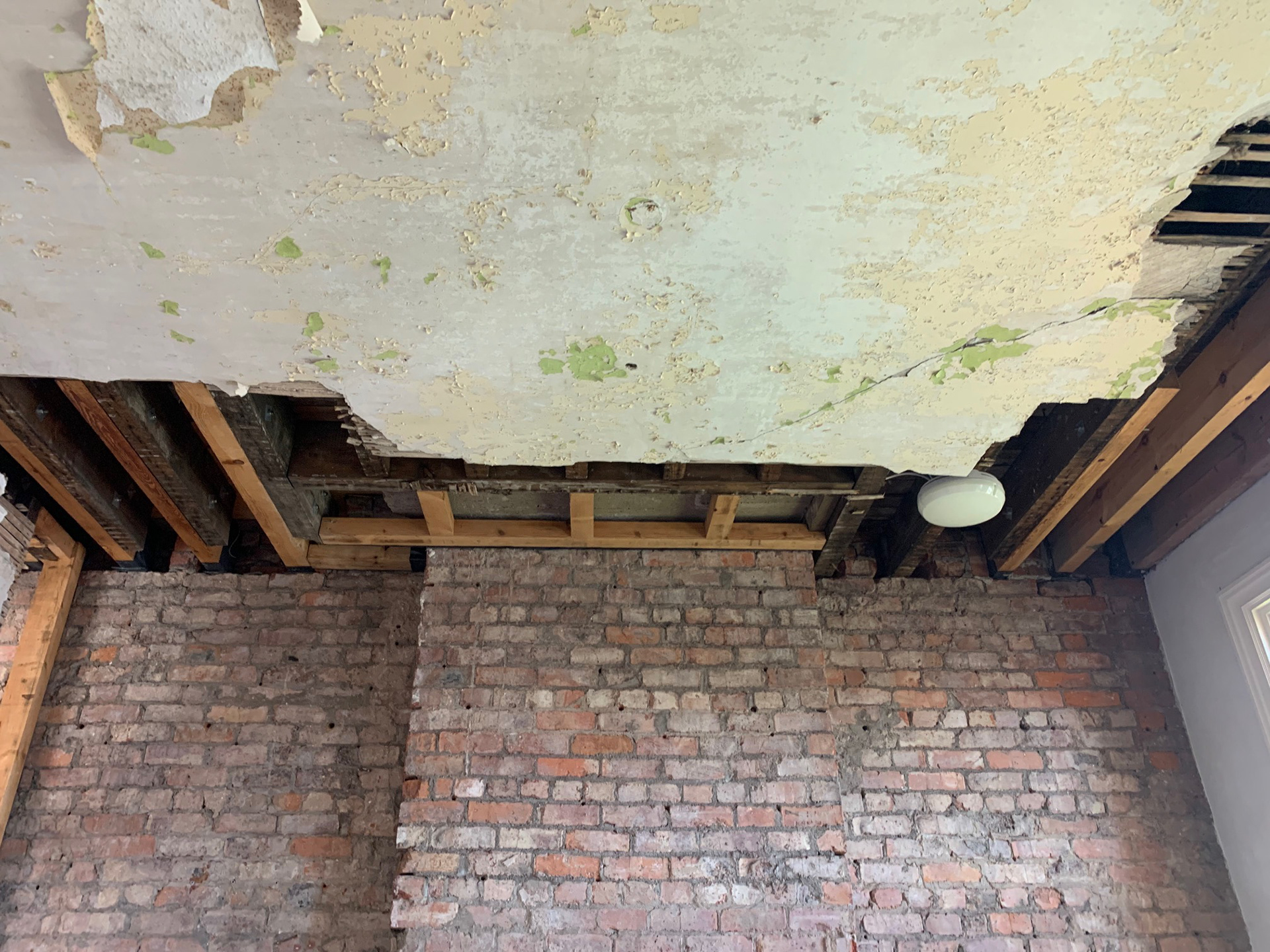
As the space was small, it meant that we had to maximise the room to its full potential. While also being respectful of the non-negotiables of using the space. This included no hanging on the walls, no screws and no blu tac.
It was outlined in the Exhibitors Manual that the room had spotlights, which would be helpful in the evenings as we would not be able to rely on natural light through the window, however we also planned to bring our own lighting as well.
Mark explained his vision of the exhibition to us, a series of 25 1m x 9" OCB boards that would support our samples. He explained that these plinths were to be no higher than 6", as to force the viewers' perspective downwards and have a more individual and rememberal time in the space.
Mark gave us full creative freedom as to how we would create legs for the display plinths but requested that we have at least 6 legs per plinth, 'similar to a caterpillar', while also reinforcing the idea that something has 'got legs'.
During our first meeting as part of the GNCCF committee, we discussed our approach to crafting the table legs. Since Mark requested a minimum of six legs per plinth, we decided to make eight per plinth. This would provide some extras and allow for flexibility in the number of legs per plinth. With 10 of us on the team, this meant we needed to produce a total of 200 table legs as quickly as possible.
To add visual interest to the display, we agreed on having plinths of varying heights, using three different leg sizes: 4", 5", and 6", in a ratio of 1:2:4. This translated to each of us making three 4" legs, six 5" legs, and twelve 6" legs.
We committed to completing these legs in time for our next meeting in five days. This meant that there would still be extra time if any legs were not completed, or if any changes had to be made.
As a group, we decided that a series of different materials would be an interesting choice for the legs, each representing our chosen specialism and complimenting the array of samples on display.
Making the Table Legs
For my chosen design, I decided to use copper piping to create my table legs.
I decided that this would be an appropriate homage to where my practice has led me today, primarily working with copper during my foundation and 1st year at MSA.
I also thought that the copper would complement the room, as when soldered it creates these interesting surface textures, which could look like the textures from the ripped wallpaper and the exposed brick.
With using copper pipe, it meant that I had to solder a plate on the top so this could be attached to the plinth, either with construction glue or nails/screws.
I used a pipe cutter to create the correct lengths, thoroughly cleaned and sanded the poles and attached a 0.7mm copper square plate.
When I first started making these legs, I was using traditional soldering techniques. This meant that I was cutting small pieces of solder and placing them around the seams to then melt and secure the pieces together.
However, after a few attempts, this was not working the best way as the solder was not melting evenly. I believe that this was due to the heat moving the solder before it had melted and then melting in the incorrect place.
After these mistakes, I then decided to use a hand soldering technique, where I held the solder in one hand and attached it to the seam just before the melting point. This then meant that the solder and the metal were hot enough to be attached and would not fly off when more heat was added to melt the solder and join the two seams.
It also meant that I could use more solder, which is also what think my first few attempts were lacking.
Making the Arrows
As part of the curation, Mark wanted a series of arrows to be made to go alongside the samples, pointing towards people's work. I volunteered to help with this as I had a couple of ideas for the design.
I decided to laser cut these arrows as this would be the most efficient and accurate way to have a repeated design. Rather than only making one arrow design, I decided to make 7. I believed that this would add visual interest and each arrow could compliment different styles of work, for example, the inner arrows being used more for jewellery, and the thicker ones being used more for bigger pieces like ceramics.
I made my designs in Adobe Illustrator and then used the laser cutter to cut these designs out in 2 different sizes.
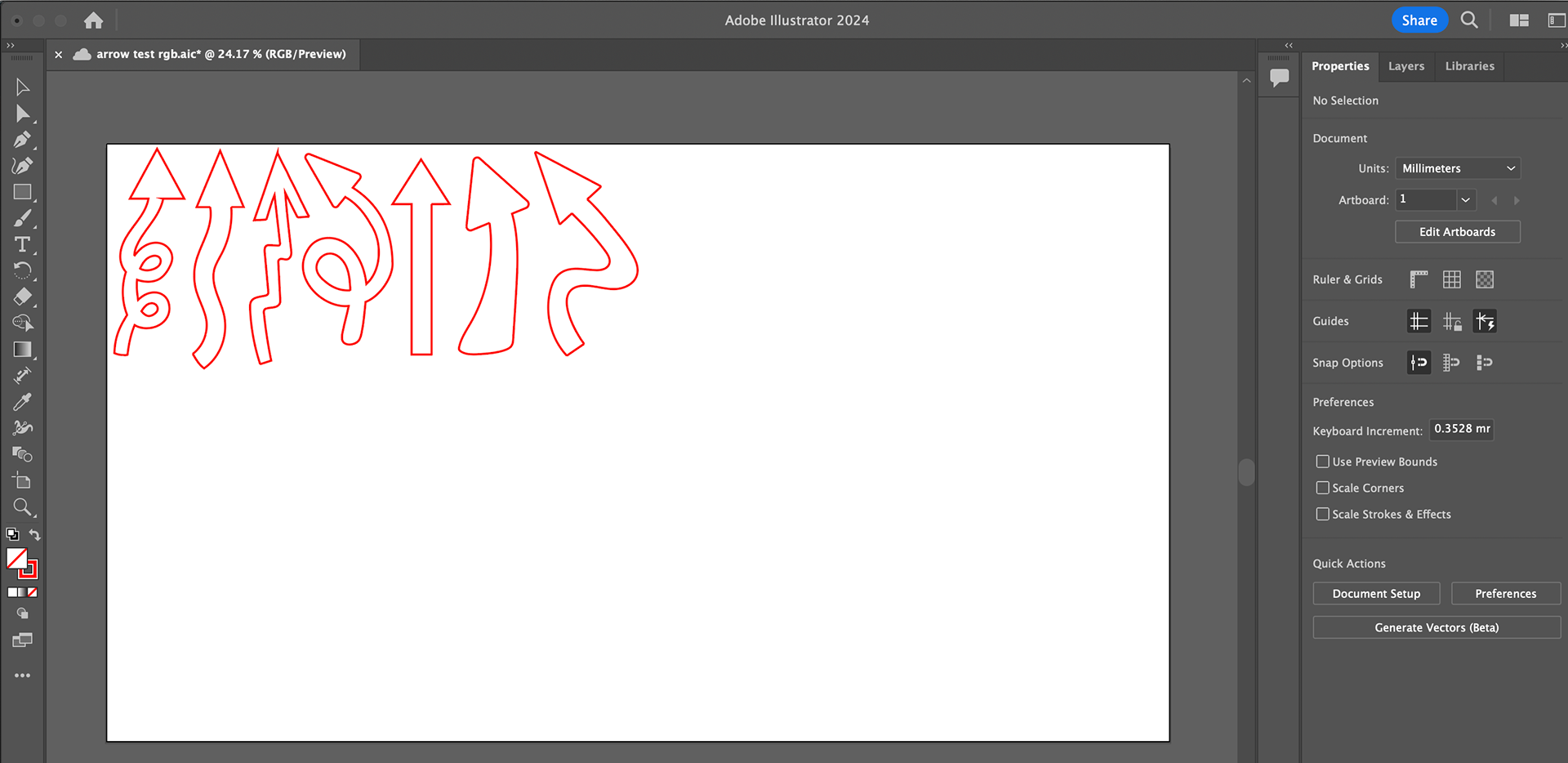
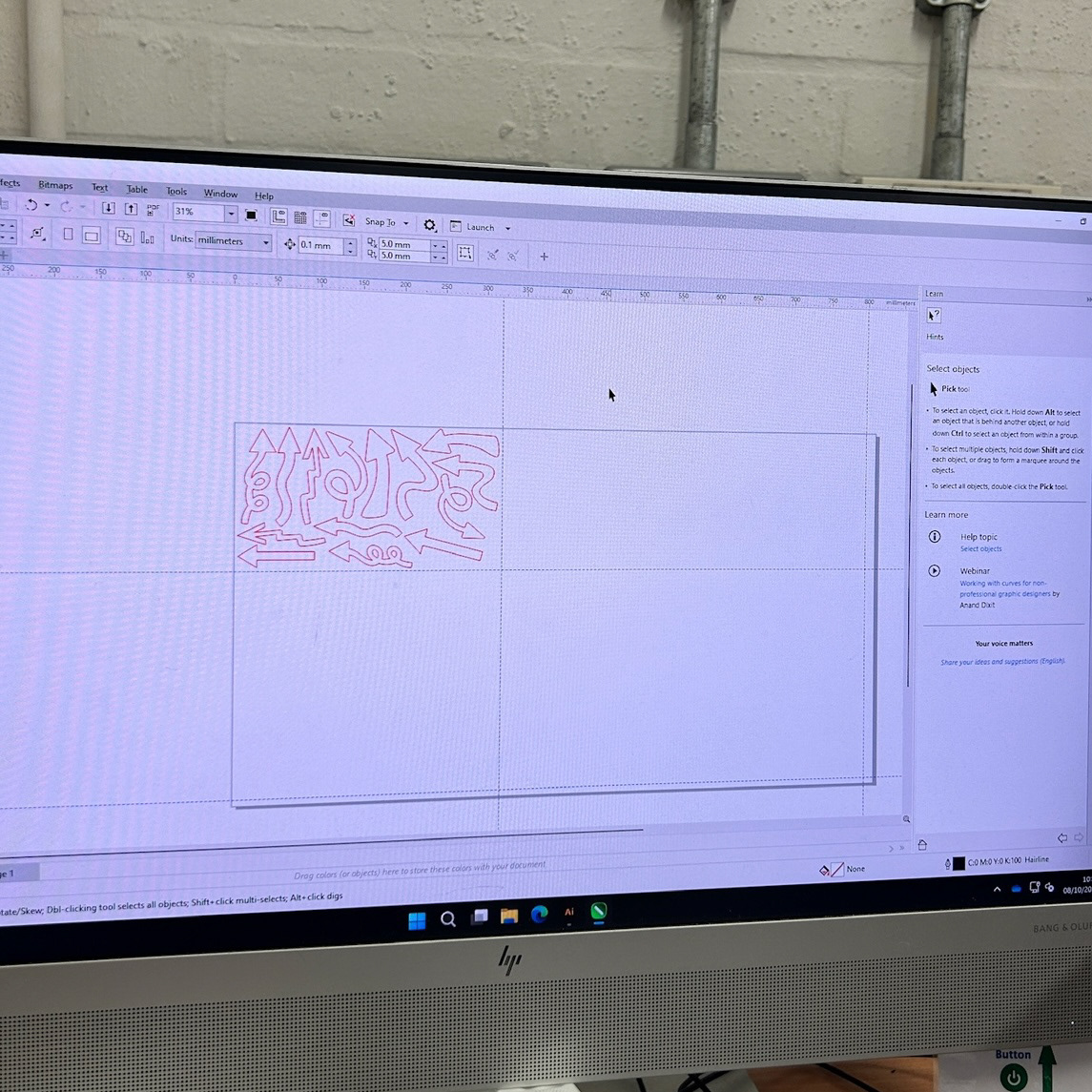

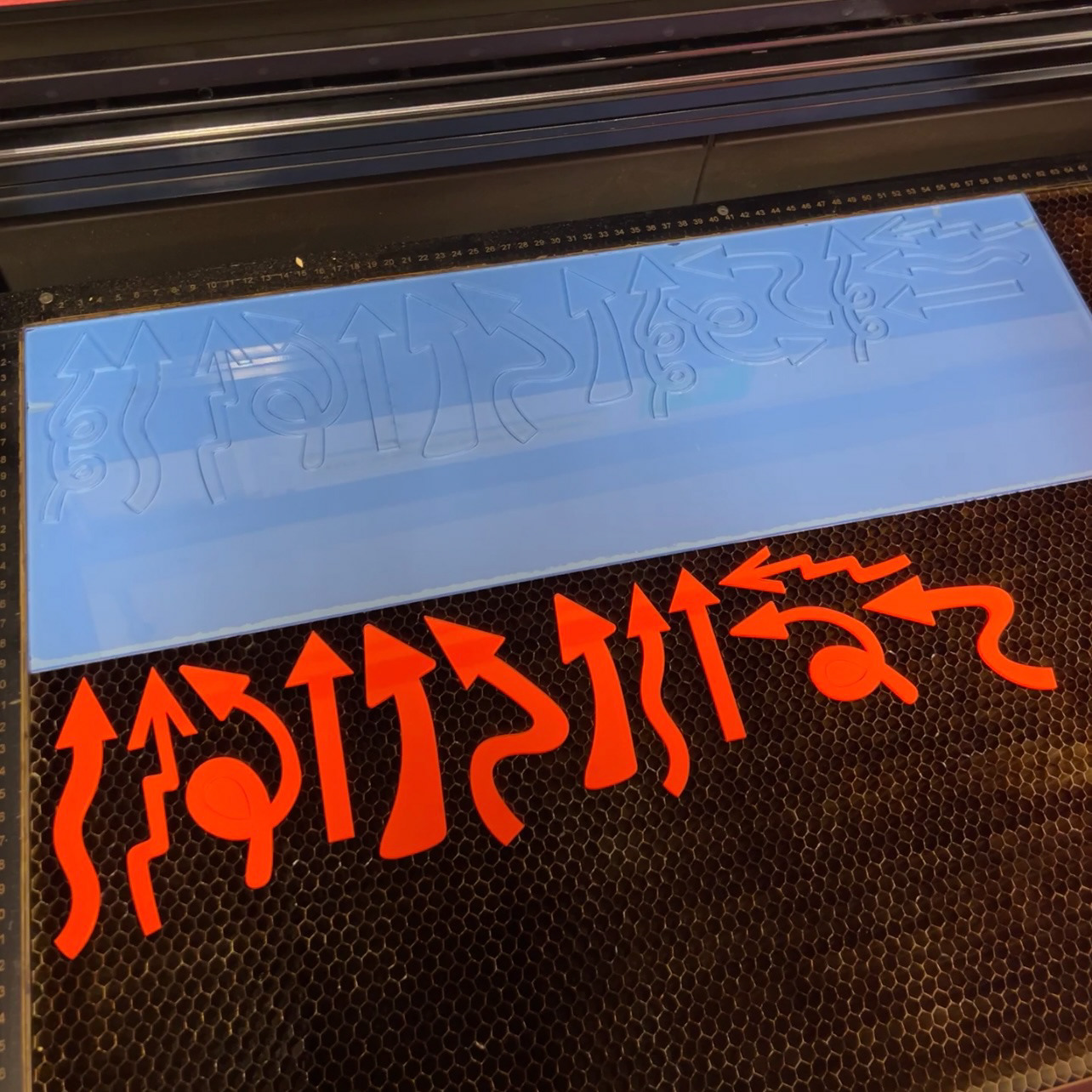
To help speed up the process of the cutting, I decided to do 2 colours at a time. I measured the boards and organised them into which pieces would fit together in the small laser bed. In CorelDRAW, I then added the lines to mark which board was which, and made my best attempt to save as much room as possible, just in case any more arrows were needed.
Due to a miscommunication in the materials of the arrows, I had first cut these out in 3mm acrylics in various different colours including red, blue, orange, yellow, white, black, and mirrored. However, after meeting with Mark, he explained that while the colours were great, the plastic material would not be suitable for the exhibition from an environmental standpoint.
While I was annoyed at myself for this setback, I was now confident using the laser cutter and illustrator and so returned later that day to make a whole new set of arrows in greyboard.
Thankfully Mark had liked the design of the arrows, and so all I needed to do was use the same file. He did request however that I make a series of circles so that he could write the number of the samples corresponding to the maker incase there wasn't enough room to do this on the arrow.
Making a Timetable
As well as making the arrows, I volunteered to make a timetable for the invigilation of the stand.
I first started by getting everyone's availabilities, and then making a timetable based on this. I had to make sure that there would be 2-3 people on the stand at all times, and because of a lot of illness around our group at the time, I decided that 3 would be a better idea, as this still accounted for any sicknesses. Having 3 people on the stand also meant that someone could go around and have a look at the exhibition while they were there and still have 2 other people on the stand and rotate doing this between them, as for some people this would be the only chance to come to the event over the weekend.

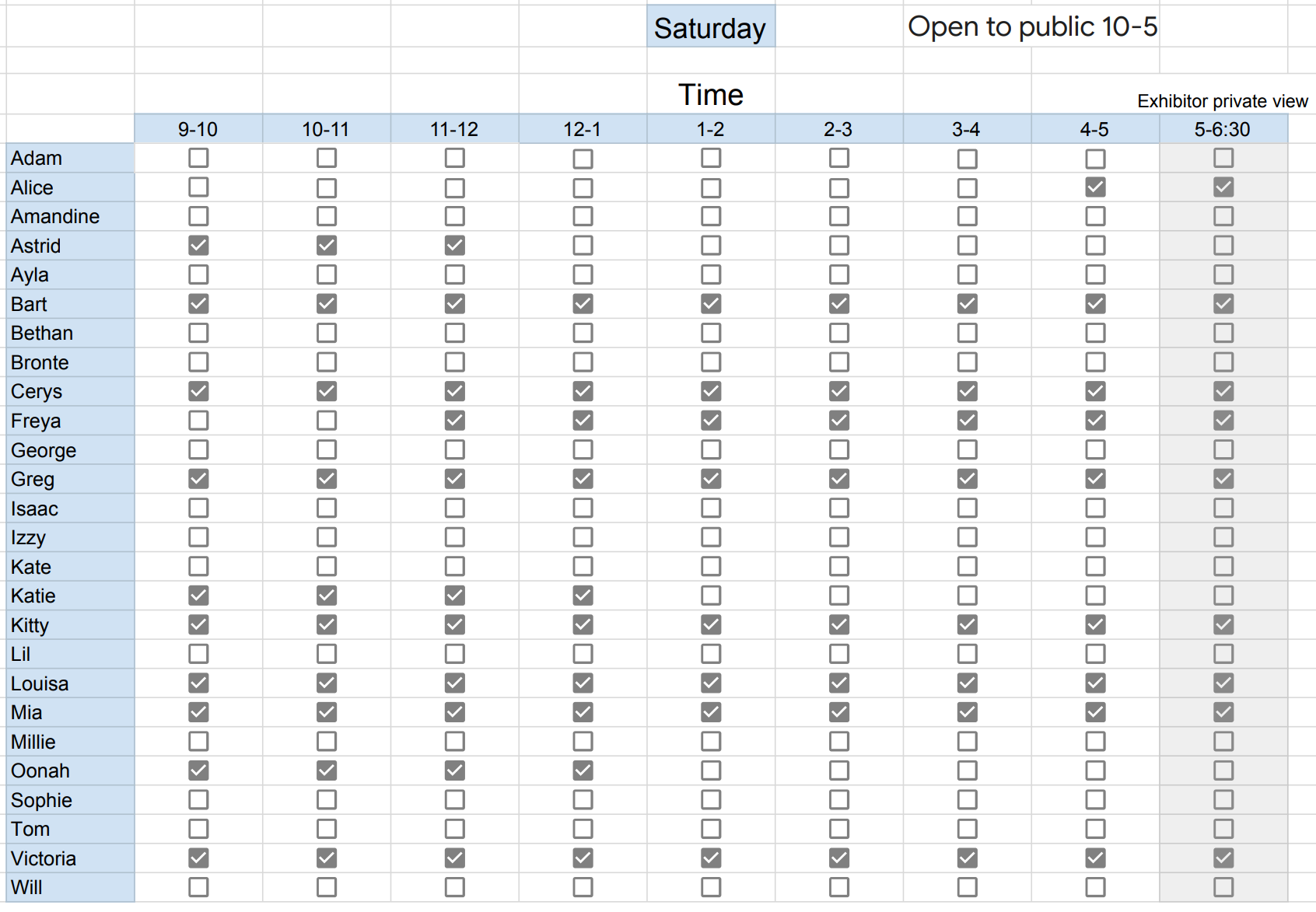
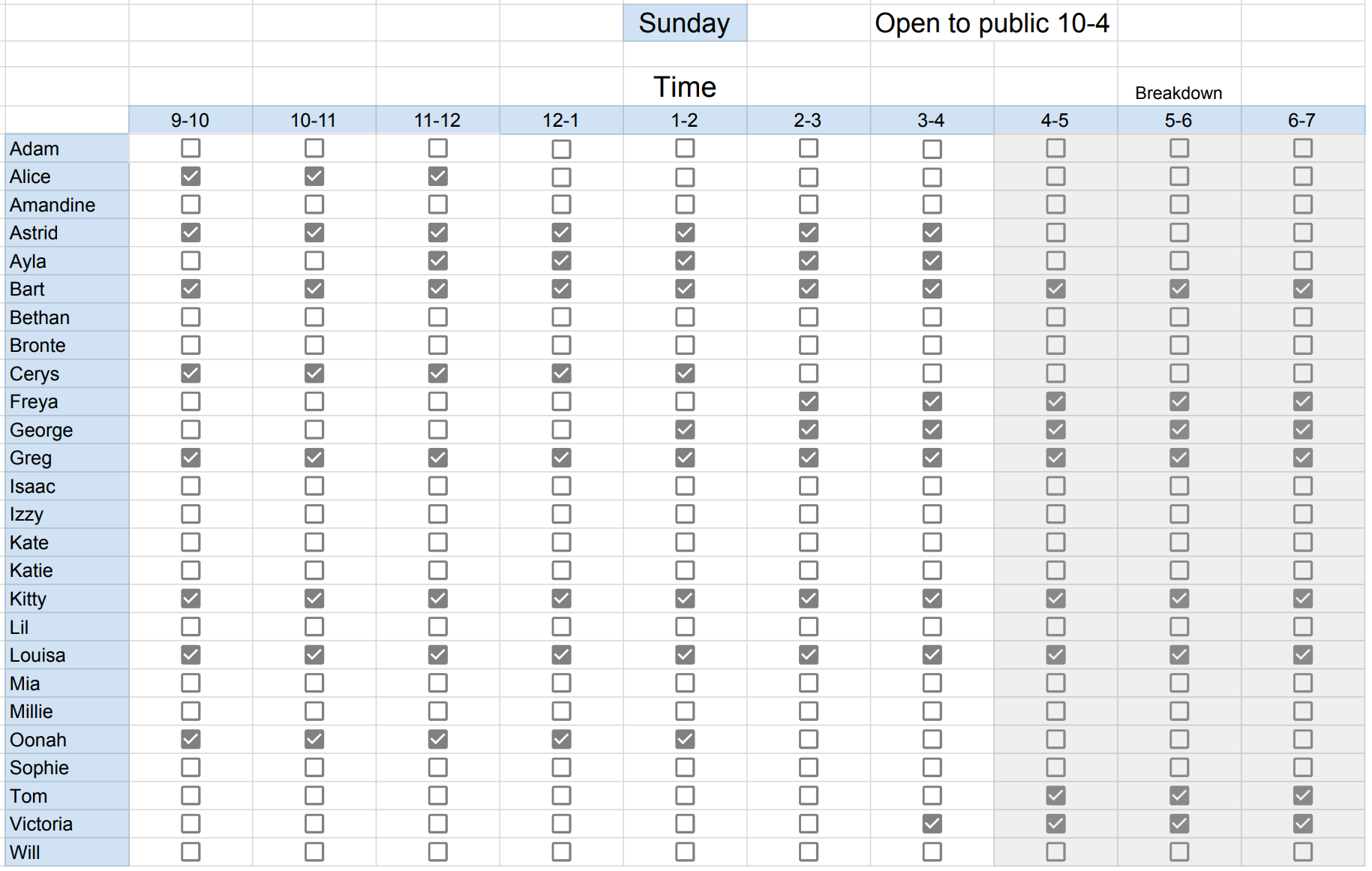
My Chosen Samples
When selecting samples for the exhibition, I found myself feeling quite stuck. As mentioned in 'Beta Project - Research and Development', I was still at a point in the project where I hadn't settled on a clear direction. However, I knew that bacteria would remain a central element throughout my work and that it would naturally build on the previous project, Understanding Context.
With this in mind, I decided to include samples of bacteria collected from Finland, along with some of the bacteria stones developed during Understanding Context. I felt that this combination would offer viewers a general sense of my project's focus, even though I was still working out the details myself.
I gave all my samples to Mark, allowing him to find the best combination of stones that would look suitable for exhibition.

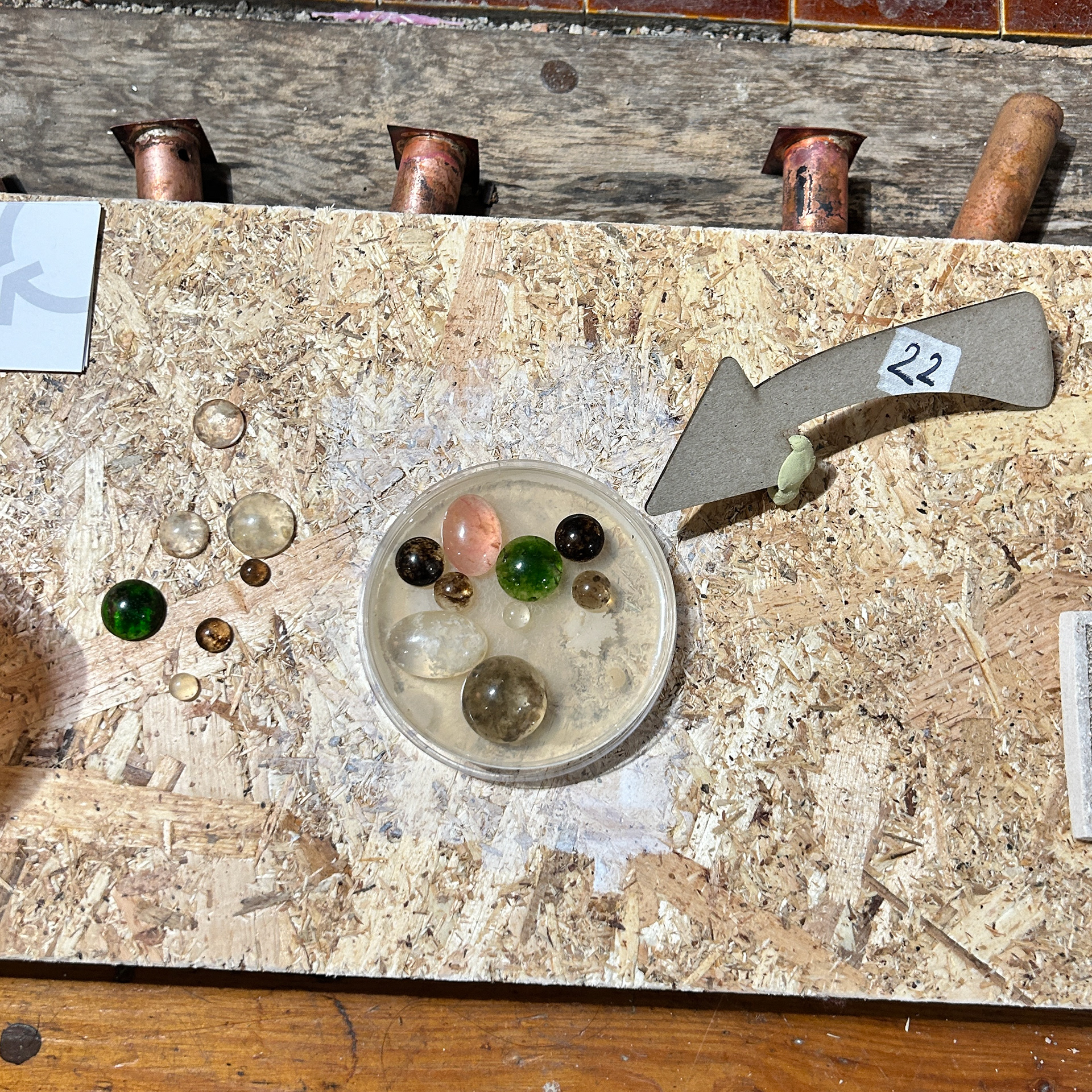
Zine Submission
For the It's Got Legs zine, made by George, I chose to highlight the bacteria grown from my samples in Finland, emphasising the sentimental aspects of my work, as this is currently a significant driving force in my practice. In hindsight, I probably should have used a picture of a bacteria dish rather than Finland, as then my work could have been easily recognisable. However, I found at the exhibition that people were intrigued about the place the bacteria came from, which reassured me about using the picture from Finland.
Packing and Loading the Exhibition
To get the samples and other exhibition parts from the University, they had to be safely packed and moved downstairs to be put in the van. I helped Oonah pack the samples, as well as move the OSB boards from the wood workshop with Astrid. I then helped load these into Len's van to be transported to the venue.

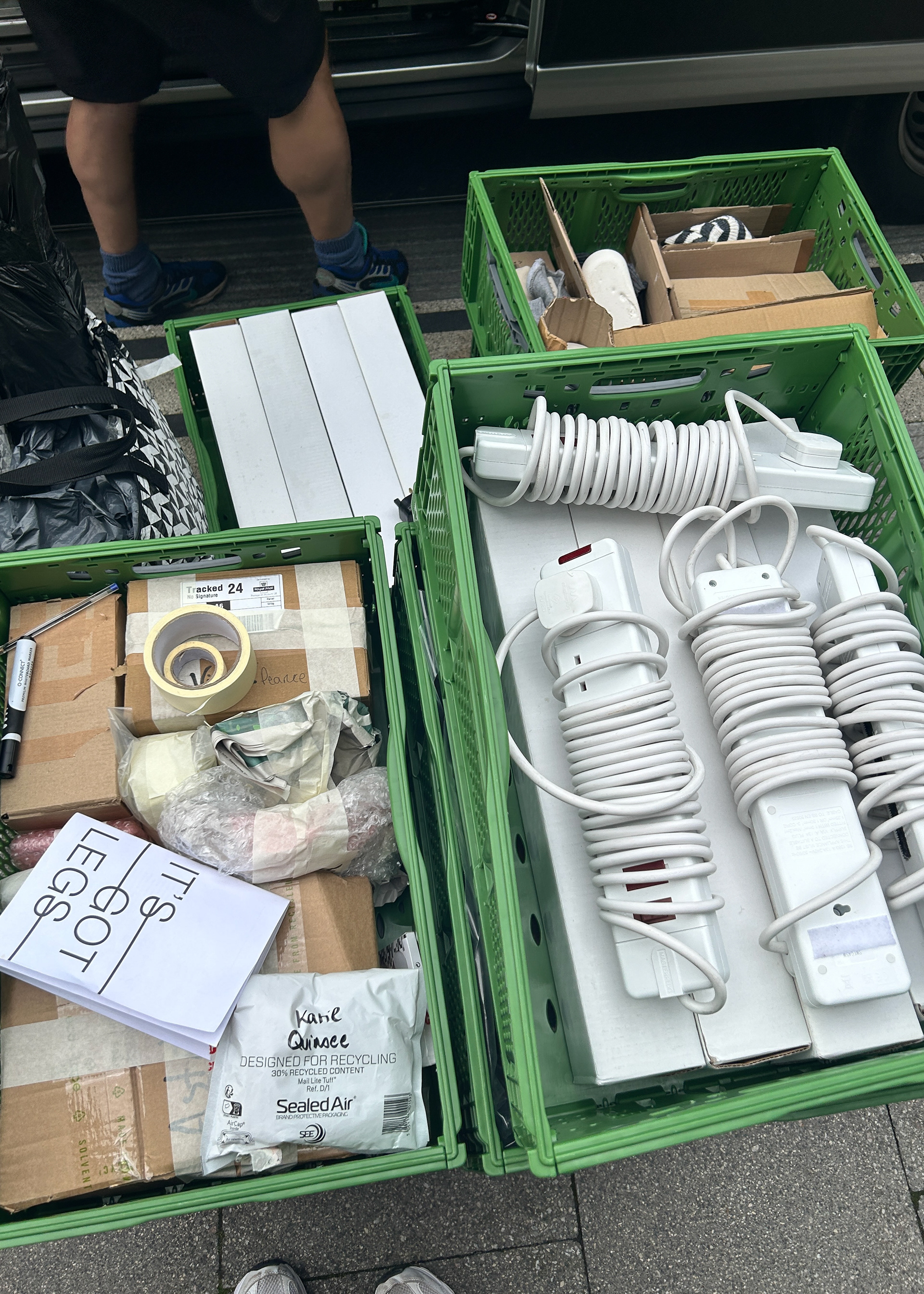
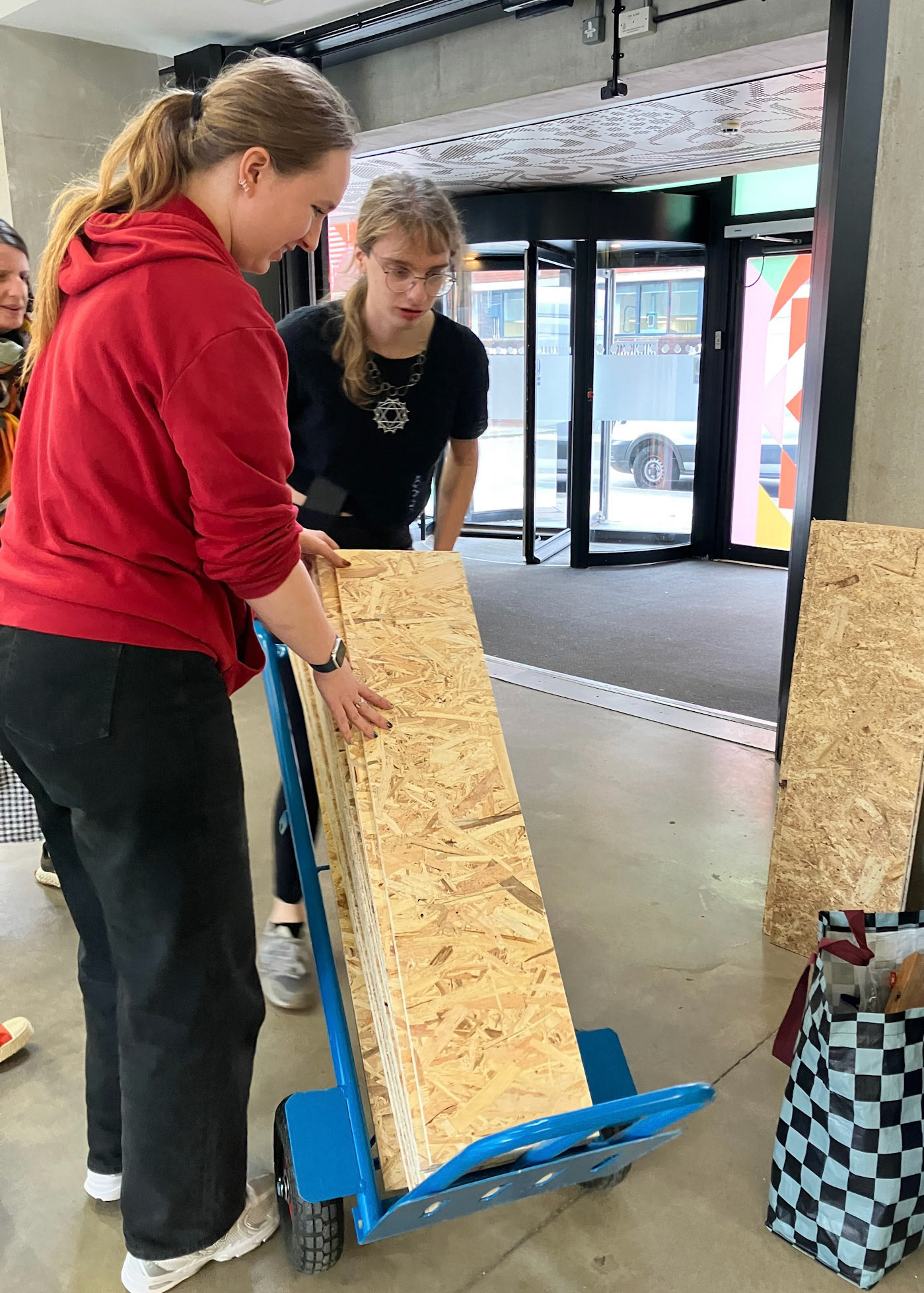
Photo by Oonah Illingworth
When the samples and equipment returned to the University after the exhibition, I also helped unload them and return the samples to the exhibitors
Exhibition
While at Great Northern I had the chance to gather feedback from the public on my project idea, and I was happy with the positive responses and the level of interest in using bacteria as a medium. Many people were fascinated by the combination of science and craft and were curious about how my project would develop. As a result, I gained around 35 new followers on my Instagram, which, while it might not seem like a huge number, is about a 26% increase in my following. I used both the zine and word of mouth to share my Instagram with others, and they were excited to see how my project might progress.
What was especially encouraging was the interest people showed in the idea of using sentimental jewellery to grow bacteria and then remaking the pieces based on the history and stories behind them. This positive feedback was reassuring and validated my approach.









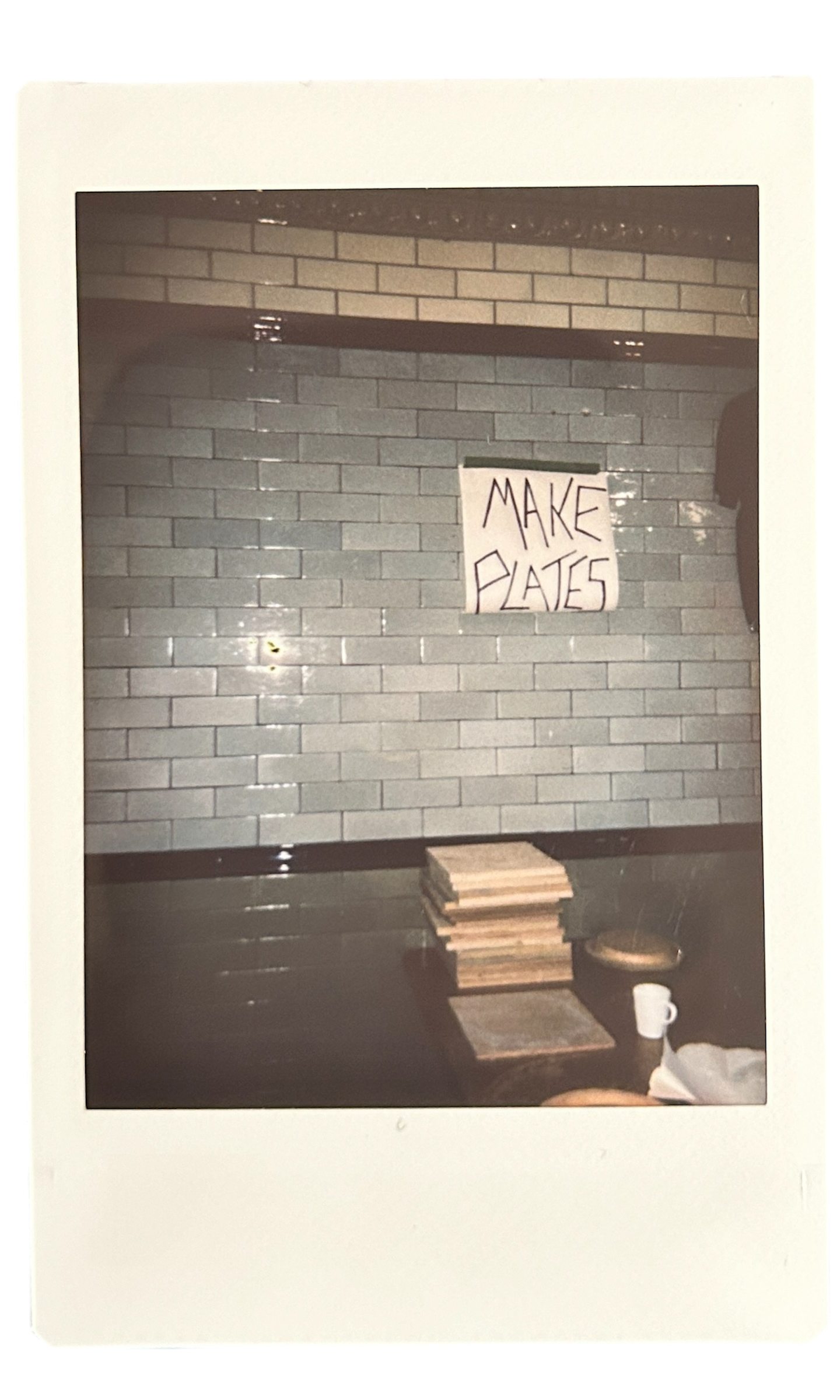
Final Display
Curated by Mark Mcleish and Oonah Illingworth
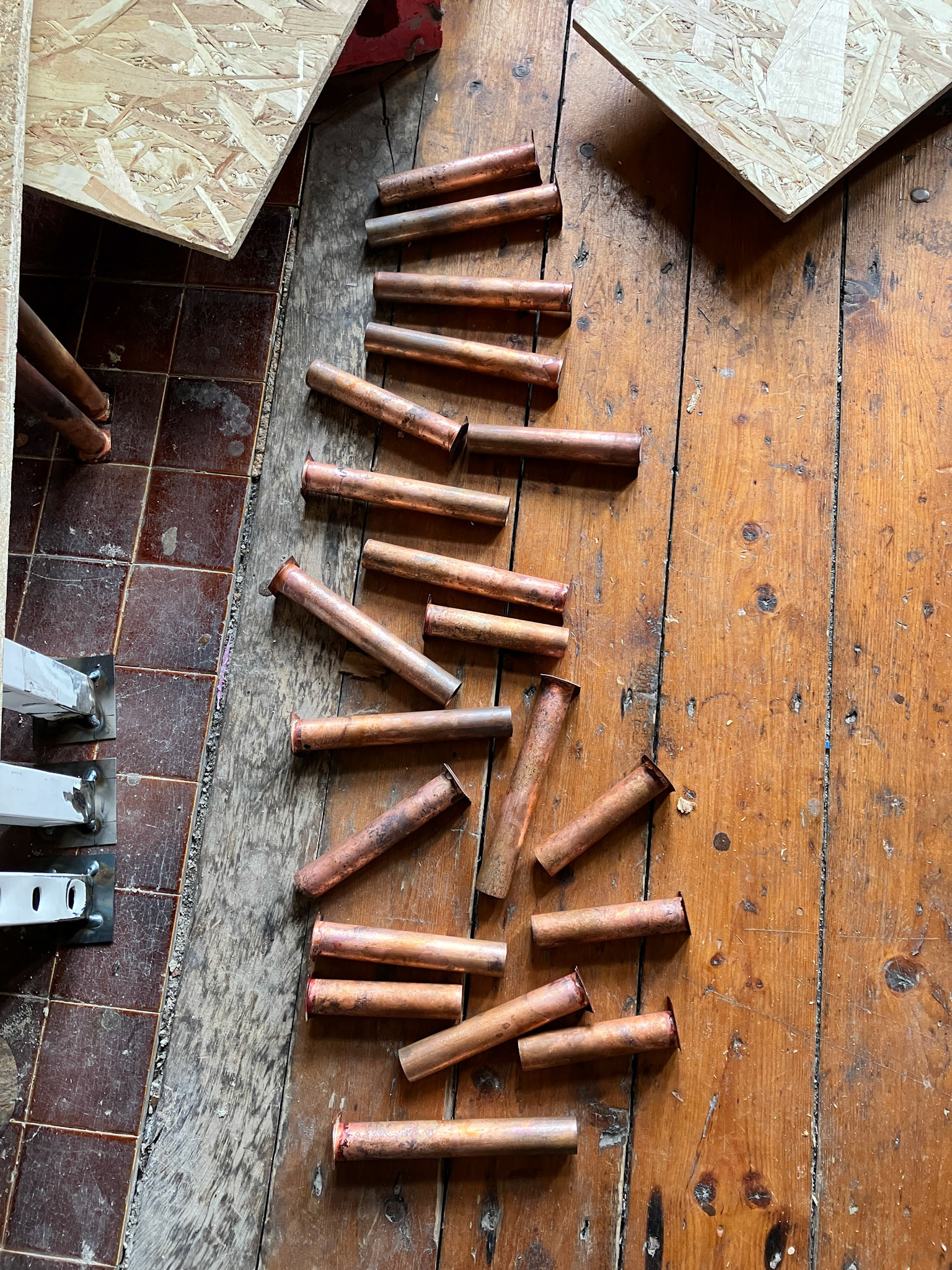
My copper legs, Photo by Oonah Illingworth
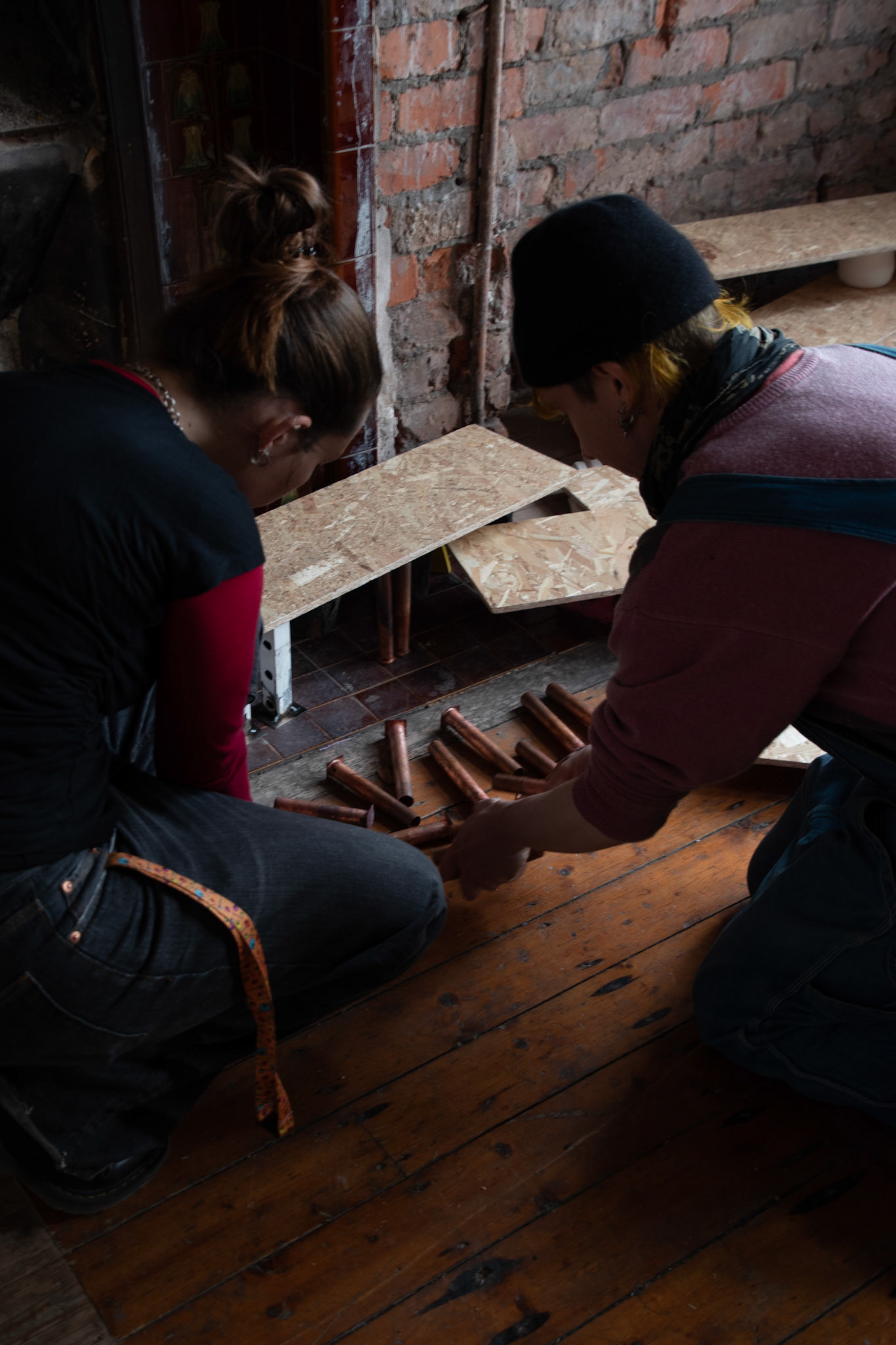
My copper legs, Photo by Astrid Davis
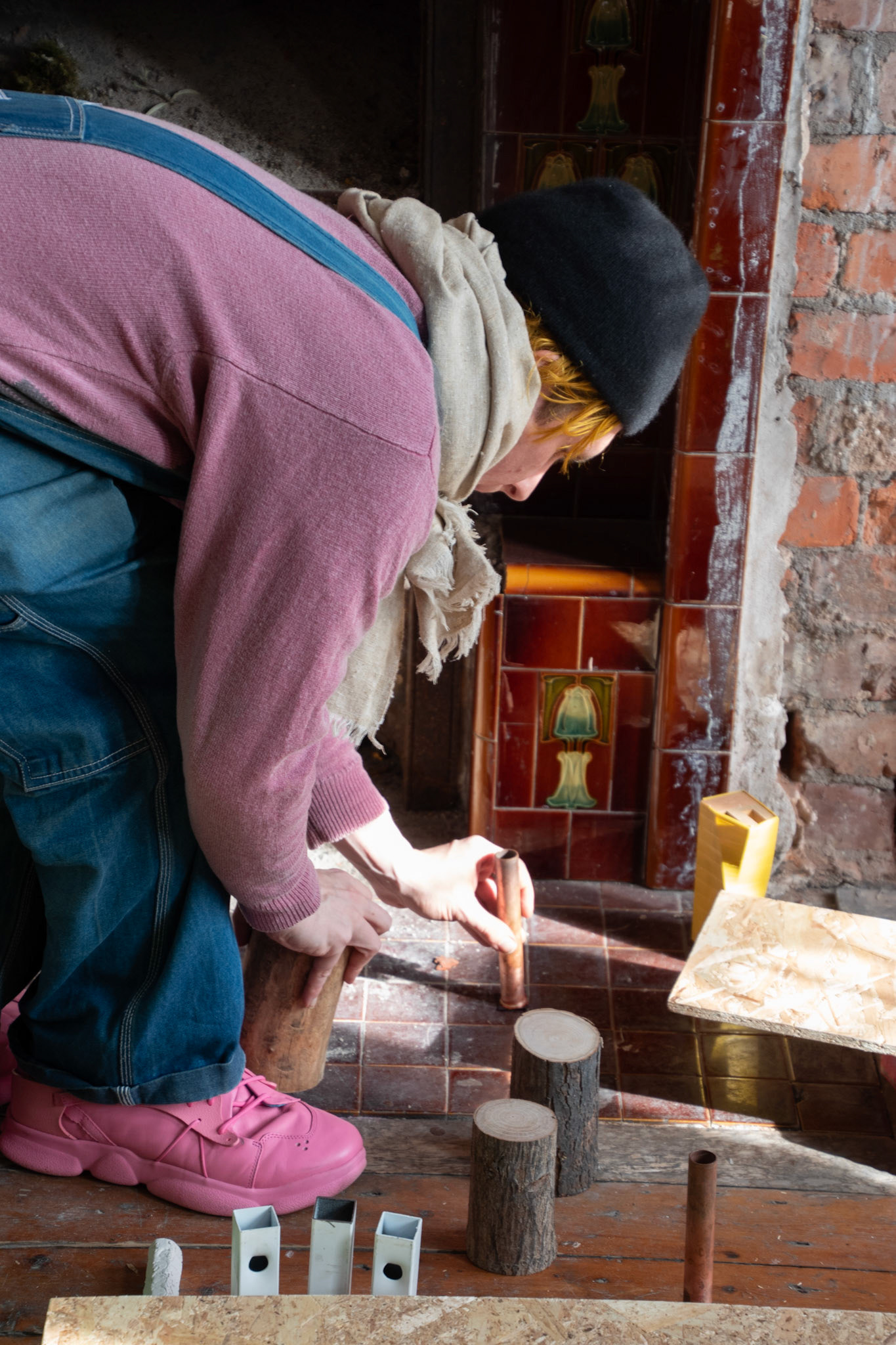
My copper legs, Photo by Astrid Davis
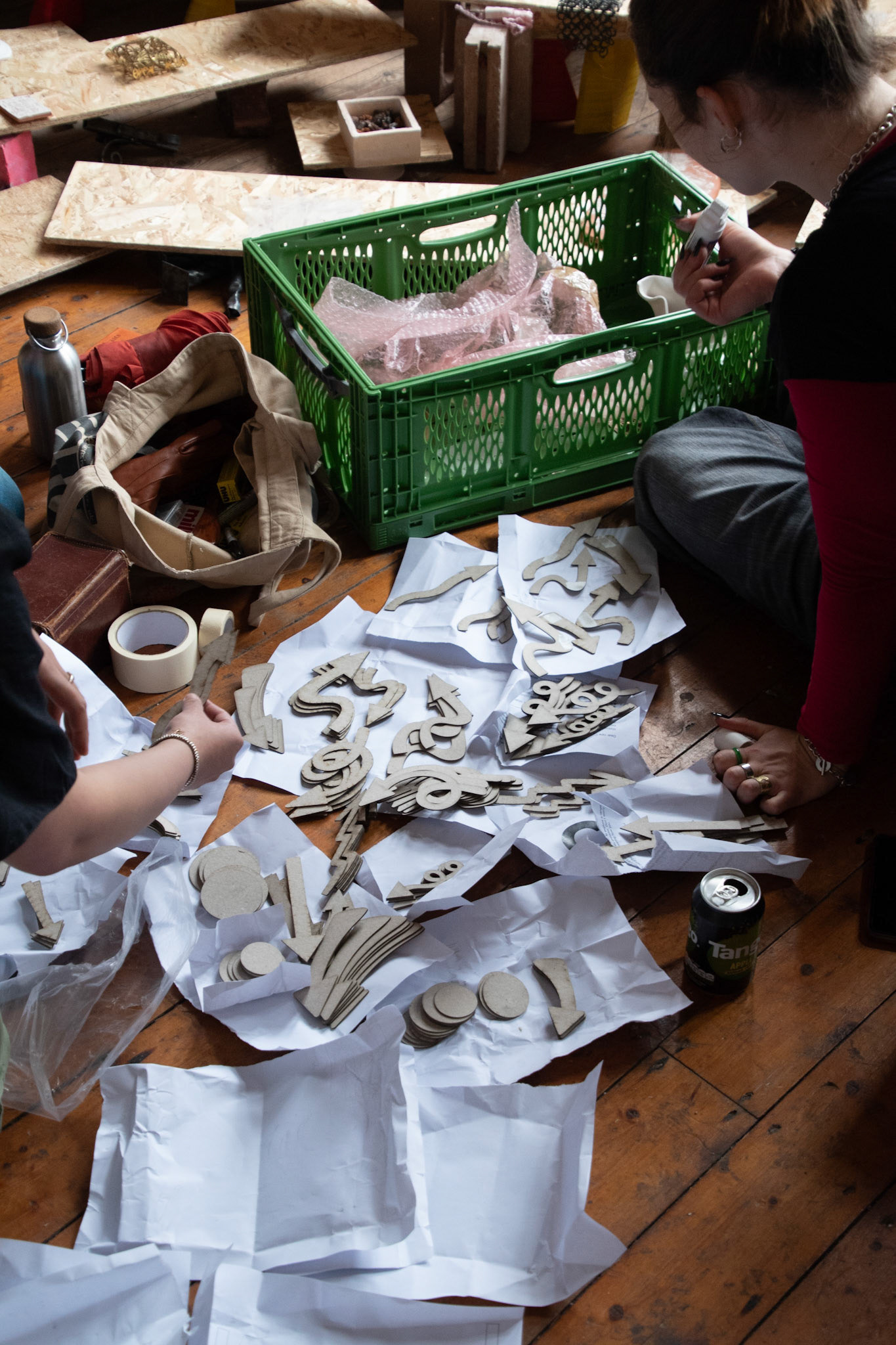
The arrows, Photo by Astrid Davis
Exhibition with lighting, Photo by Astrid Davis
“I love the way you guys have set it out in here, so inviting!”
- A visitor to our stand
During the exhibition, I invigilated our stand during both the private viewing on Thursday and on Saturday morning. This allowed me to engage with the public about not only my work but also the work of my cohort. I really enjoyed explaining these processes to visitors, especially as many were unaware that courses like ours exist. Many visitors were intrigued by such a diverse display from completely different specialisms, and I found that having a solid understanding of my peers’ work was beneficial. If I was unsure, I could always refer back to the zine, which helped clarify details while also being an effective way to share Instagram handles, especially since the QR code took people to portfolios rather than social media.
Being present on the stand also meant I could gather feedback about the display.
Many people said that they enjoyed seeing the different works on display, especially when I mentioned that it was only a sample show created in just three weeks. Without short descriptions in front of each piece, it encouraged me to engage directly with visitors, which boosted my confidence. Additionally, the dynamic displays invited viewers to interact more closely with the work, like bending down to see the small details. I also think that the lighting and the white backgrounds being some people's works helped highlight everyone's work well.
However, some aspects of the setup proved challenging. For instance, the low placement of the display and the zine on the ground made it slightly inaccessible for some visitors. Although someone was always present to assist, a higher plinth for the zine would have been more convenient, as some people didn’t notice it until it was pointed out.
I also felt that many visitors overlooked the display in the corner, likely due to the lengthy paragraphs. A shorter statement might have been more effective, though it was nice to see everyone's name corresponding to the numbers on their work. However, there was also a couple of spelling mistakes of peoples names on the board and in the zine. While the committee told everyone to double-check names, it would potentially have been a good idea to physically go around to people and check these, rather than relying on people seeing the messages and checking it for themselves.
Additionally, I think having a consistent policy on business cards may have been a better approach, as it gave the impression that everyone without business cards was unprepared for the exhibition.
Having invigilators from other courses would have also been beneficial, as we were unfamiliar with the context of their work. Without this knowledge, we couldn’t fully represent the university, which occasionally left us looking unprepared.
Lastly, I think there needed to be better signage to the room as many people did not realise that we were upstairs, nor knew that we were from MSA and were doing a sample show. While I spoke to people who came into the room and explained what the exhibition was about, I think having signage either on the door or across the hall would have worked well.
Use of the Arrows
As the first set of arrows I made were no longer being used, we decided as a group that they should not go to waste! We came up with the idea to make the arrows somehow wearable, whether that be a brooch, a necklace or even a ring. This idea also meant that we could be recognised as MSA students during the exhibition as all of the arrow shapes were the same as the ones used for our displays.
Here are some of the examples:
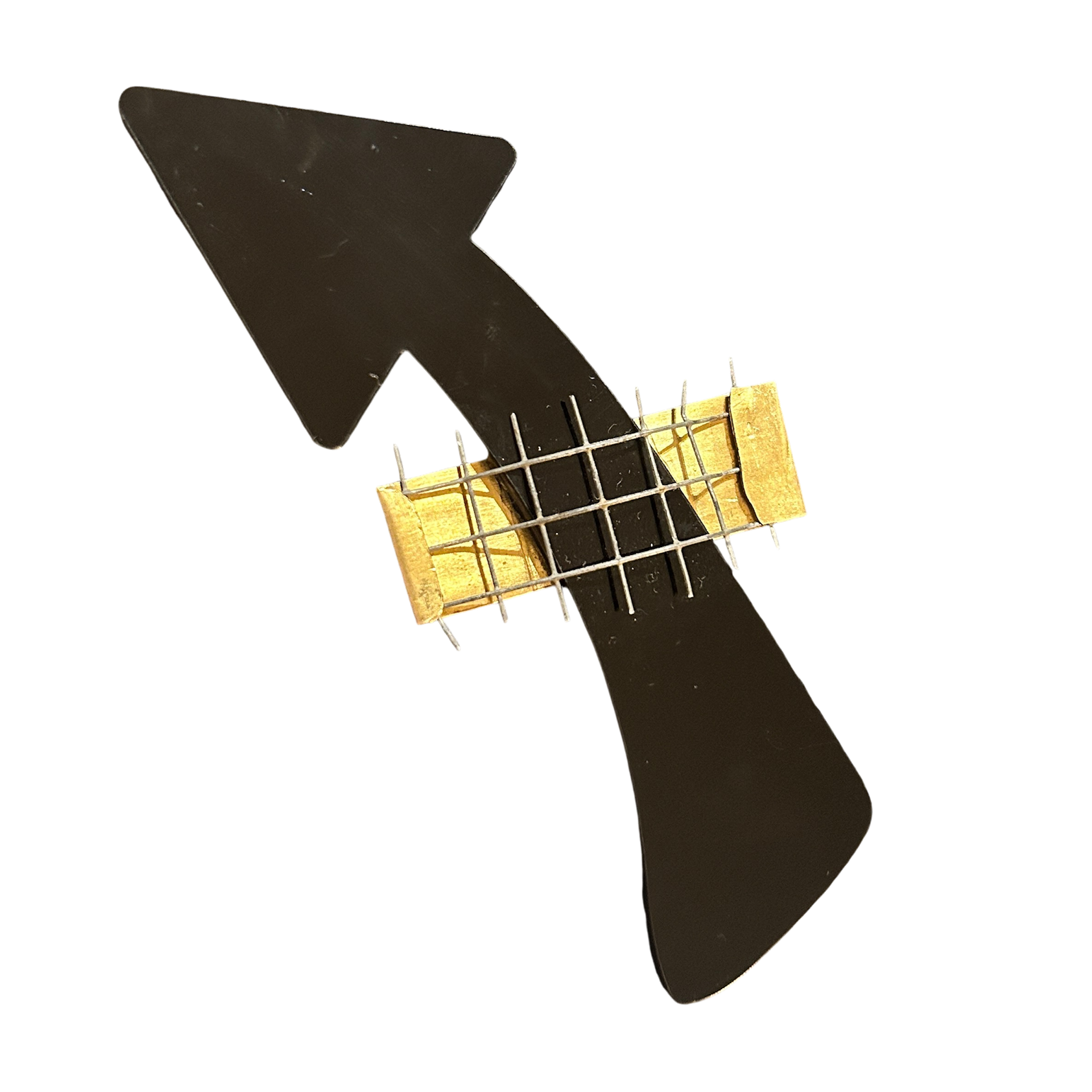

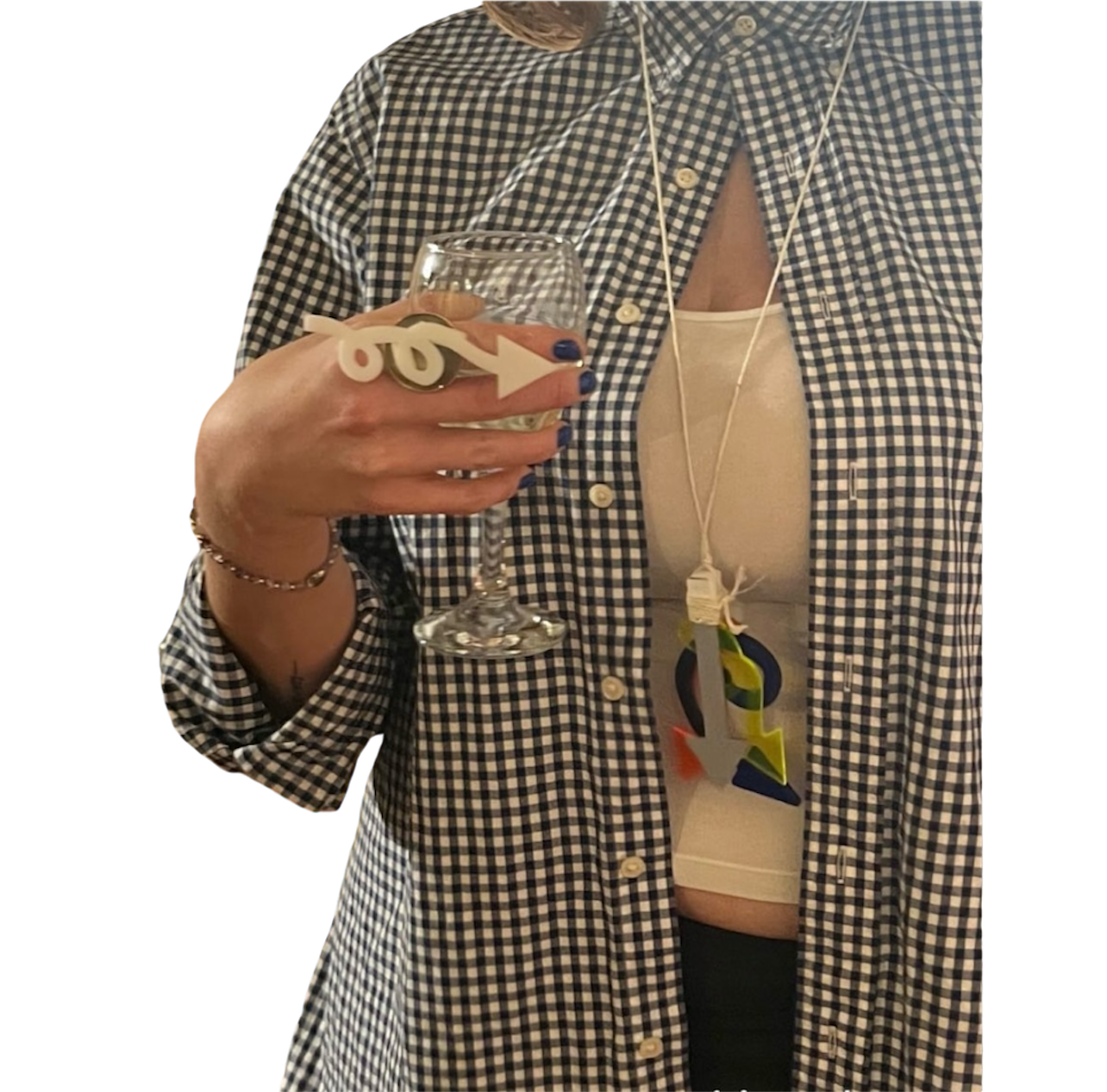
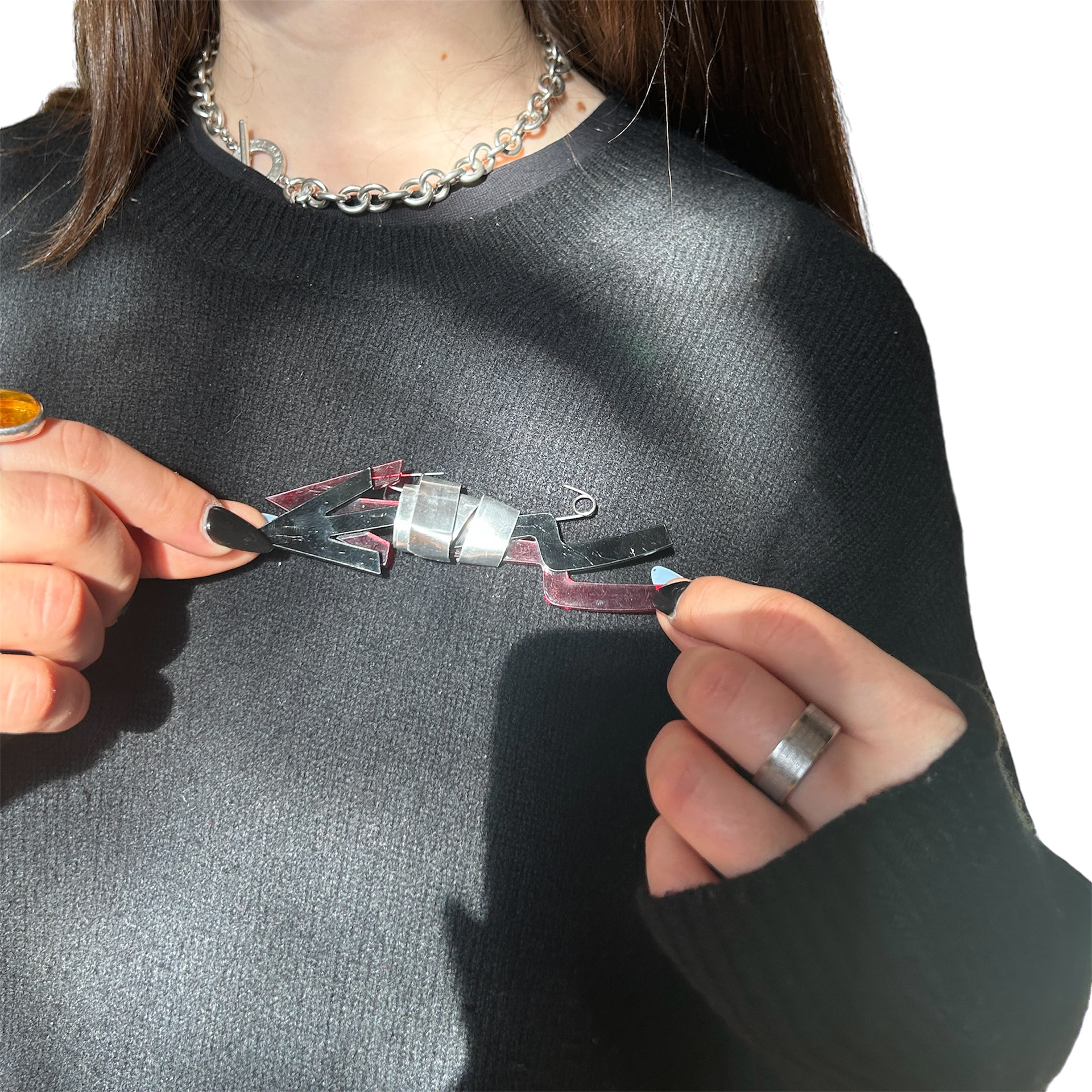


Other Exhibitors
While at Great Northern, I also had the chance to visit the other stands and speak to other exhibitors.
Lois Lo
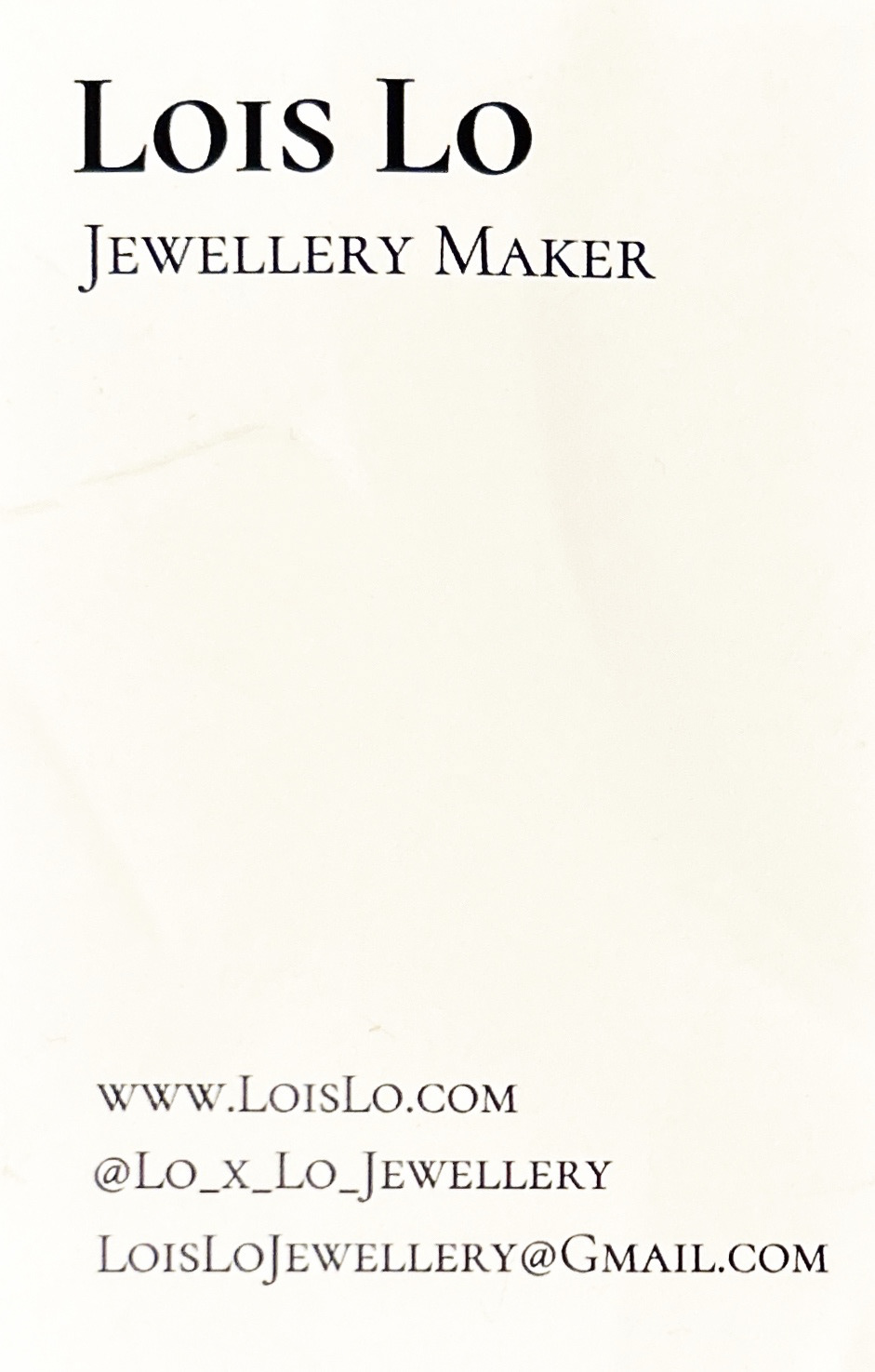

Lois Lo is a recent graduate, with a BA in Jewellery Design from Central Saint Martins and a Jewellery and Metal Masters degree from the Royal College of Art in 2023.
I spoke to her about how she had found being a graduate, to which she said that she has "enjoyed making work without the pressure of grades and pleasing her tutors".
We discussed how I was currently a student exhibiting a W.I.P show, and she explained that I should make the most of any opportunities like this, as she wished she had come to Great Northern as an undergrad.
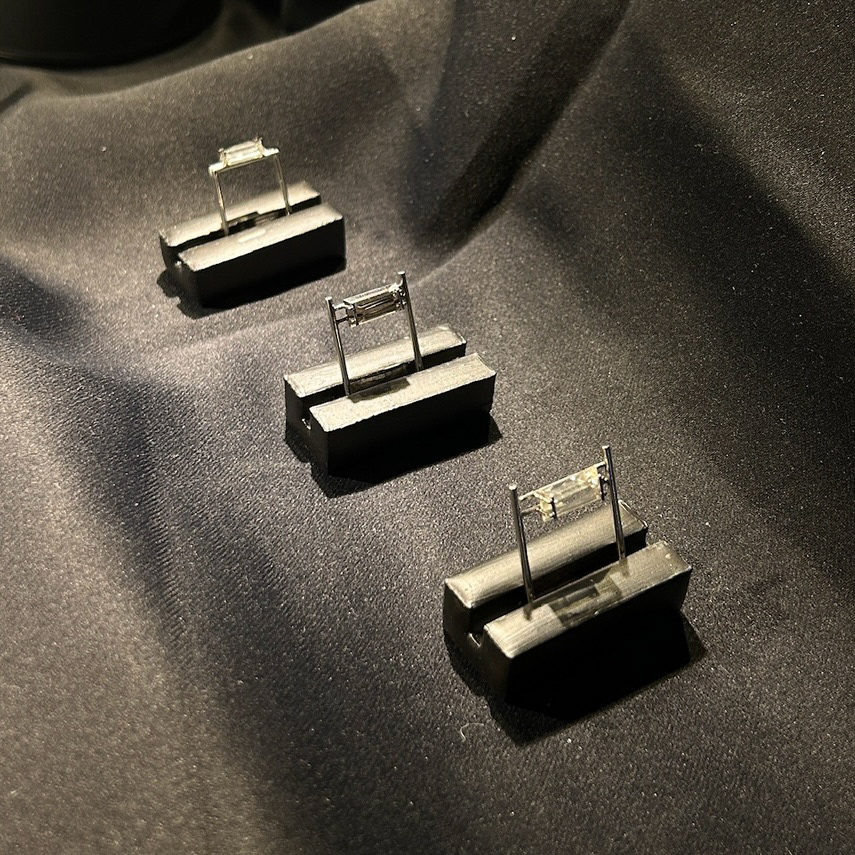


I was drawn to the delicacy of her work, as well as her innovative approach to stone setting. Her use of stainless steel instead of silver or white gold introduces a combination of both brutalist and minimalist effects while also achieving delicacy.
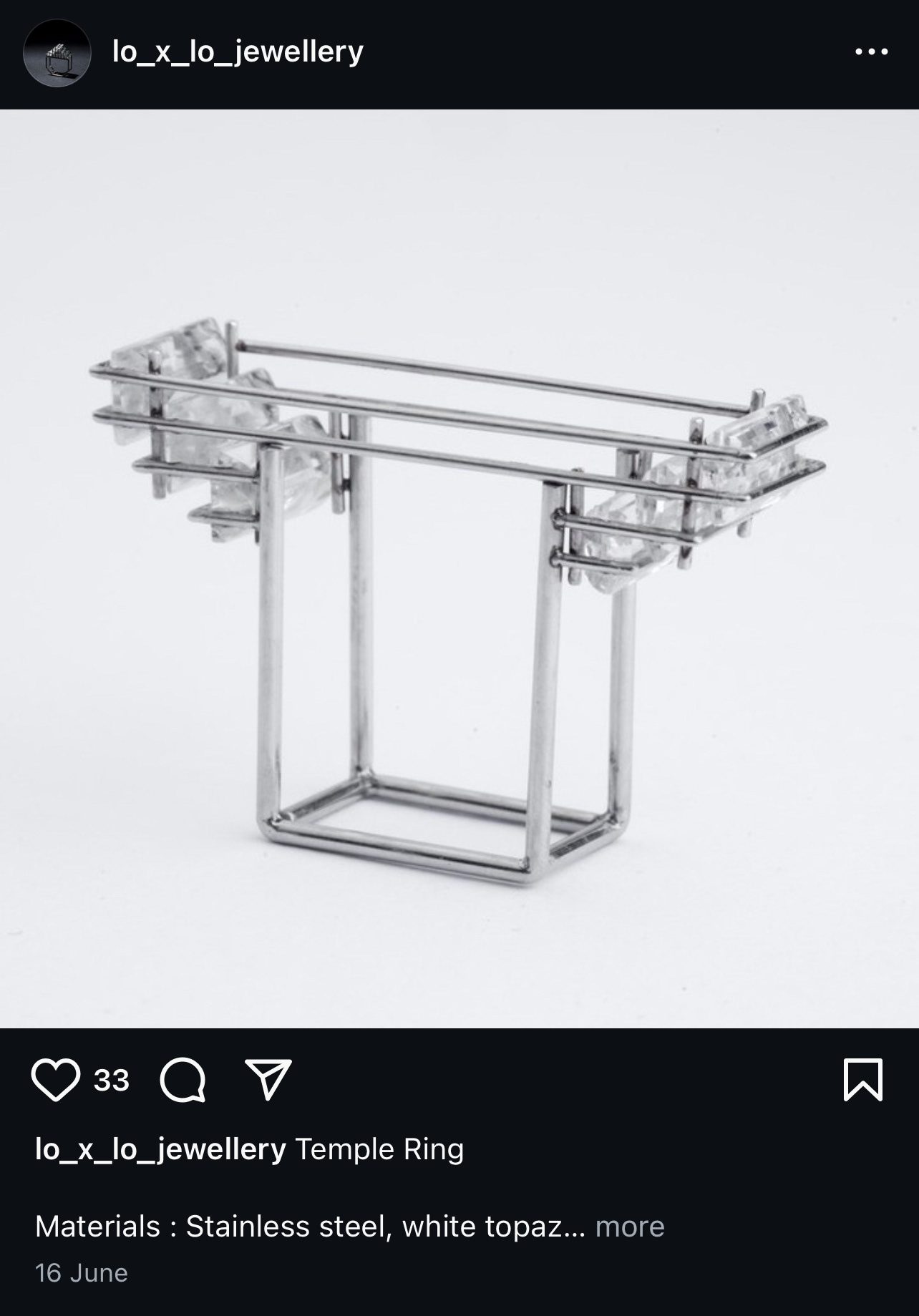
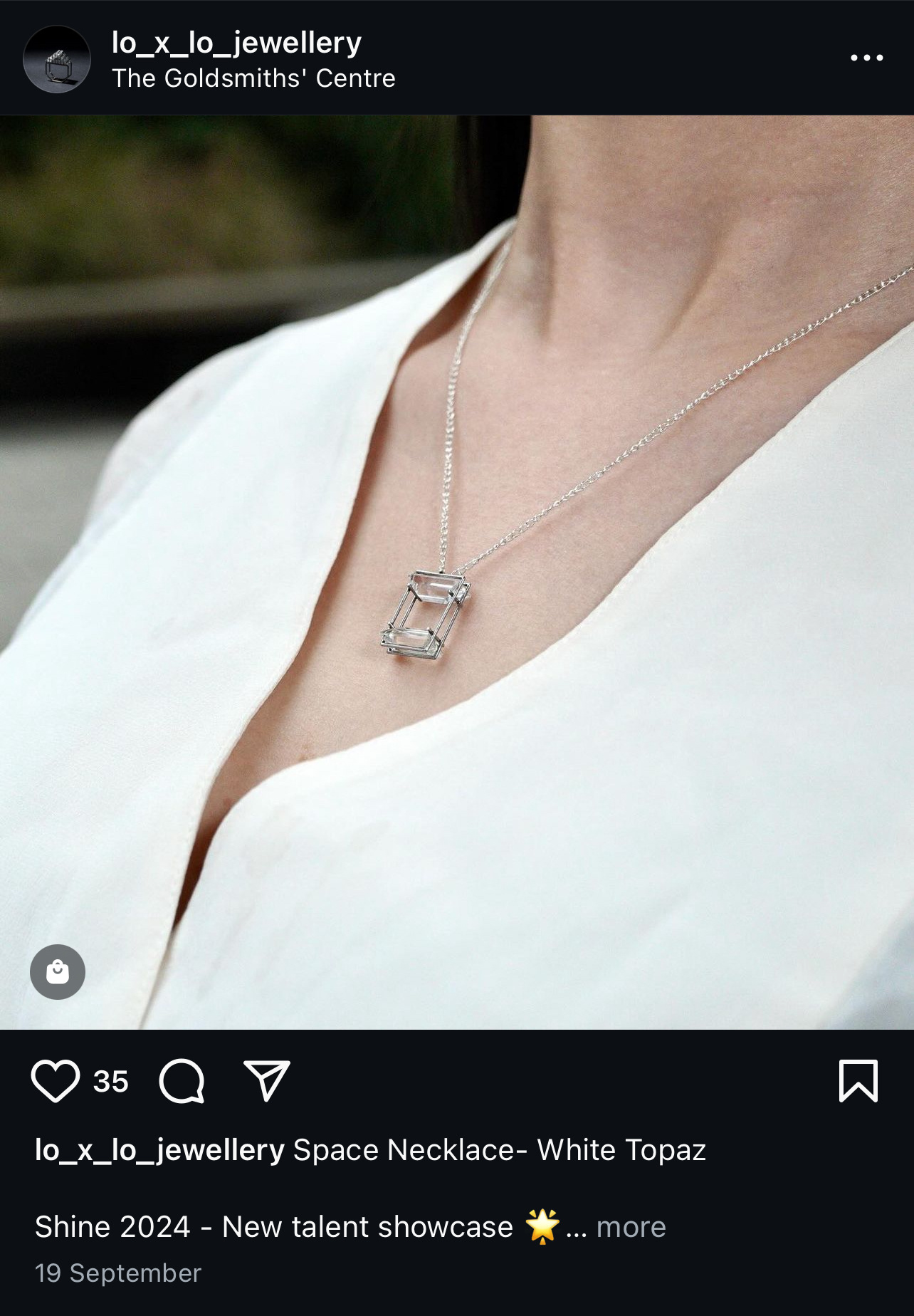
Jennie Gill
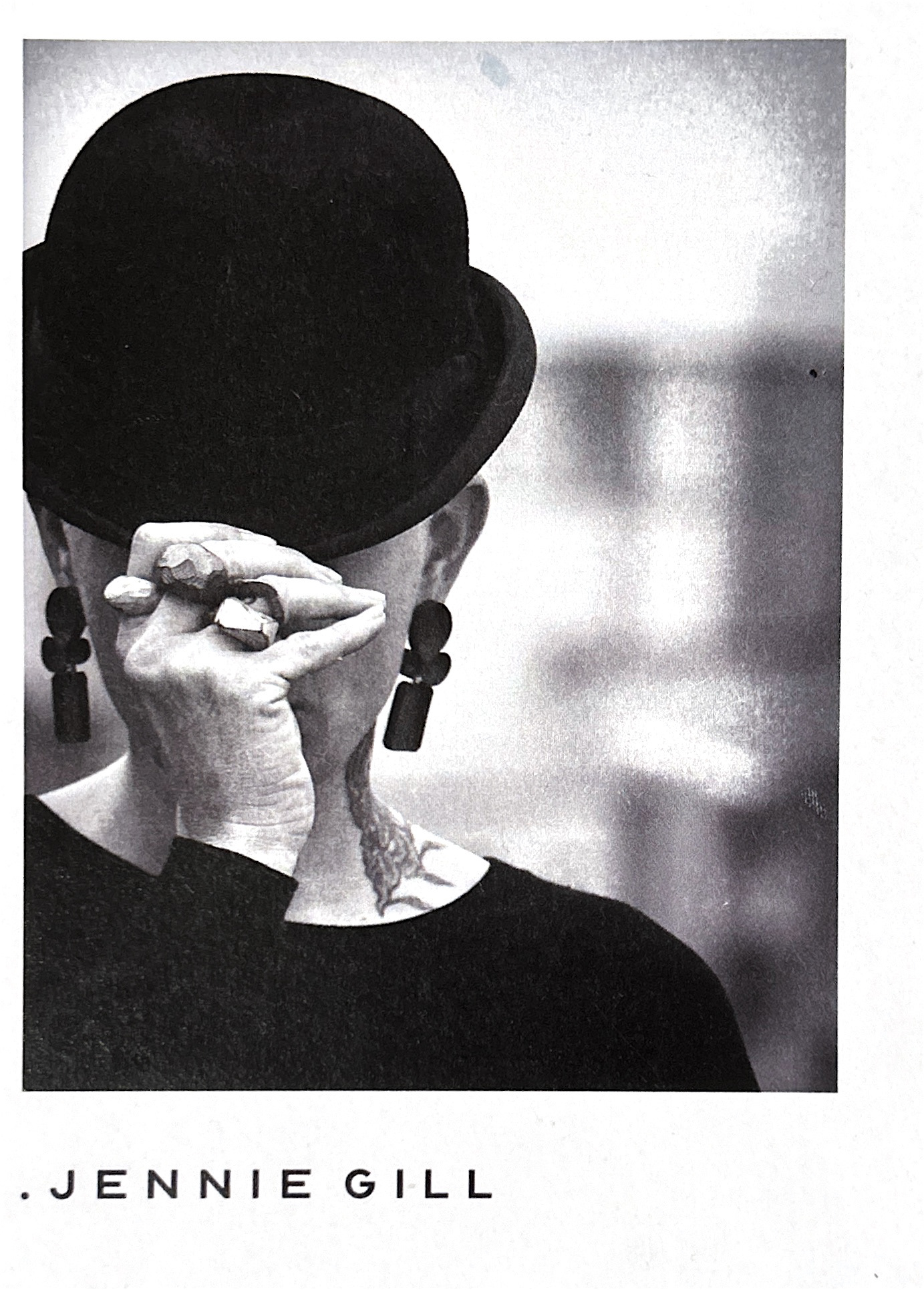
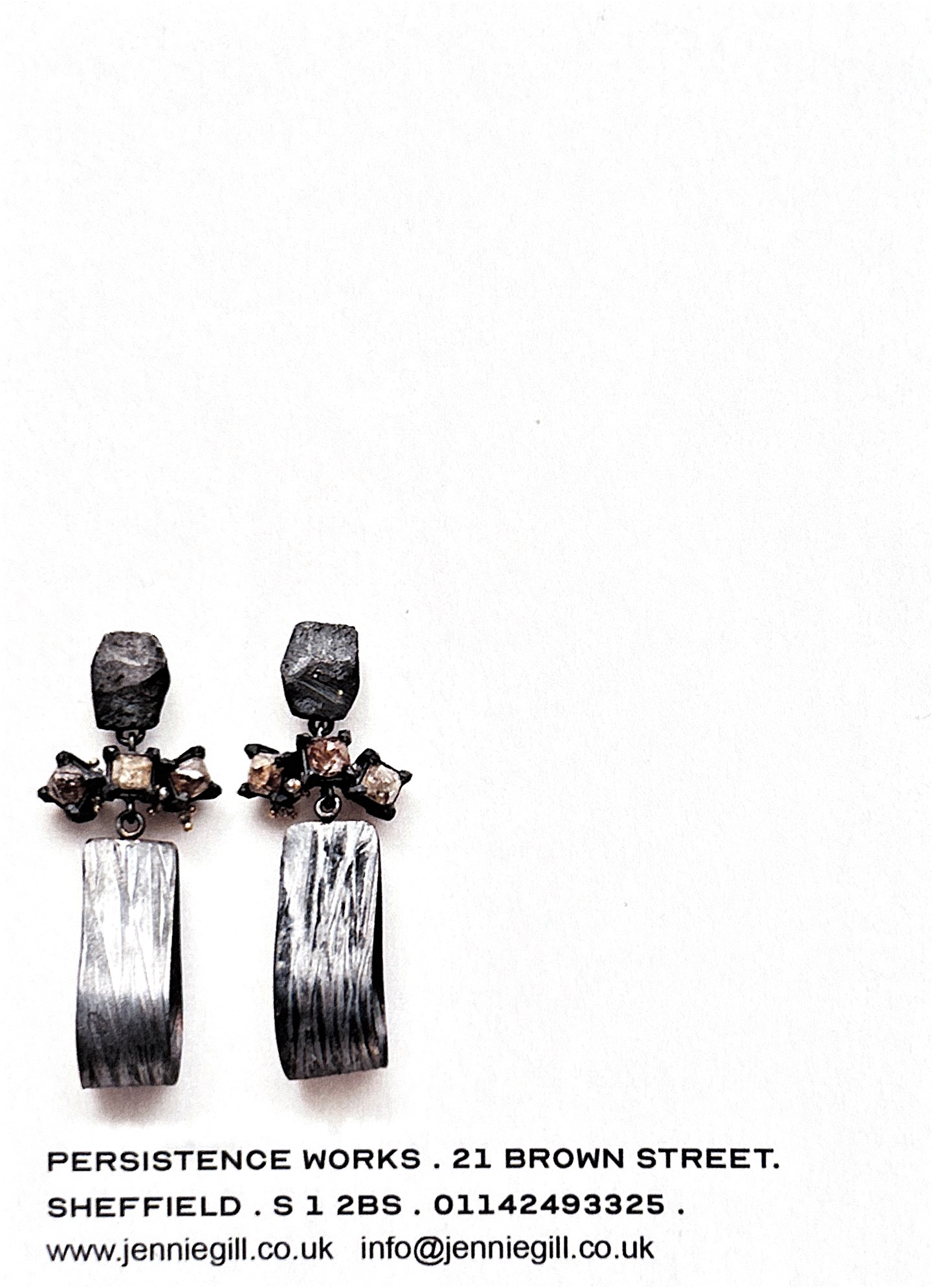
Jennie Gill is a Sheffield-based jeweller with over 25 years of experience.
I spoke to her about how she has stayed motivated throughout her career, to which she explained how she doesn't plan any of her pieces before making. She relies on being inspired by the materials at her bench, meaning that every piece is slightly different, rather than making the same thing over and over.
Her advice to me was to just continue to make what I want and to not be so reliant on planning everything before making, as often the best design choices come from responding to the material.
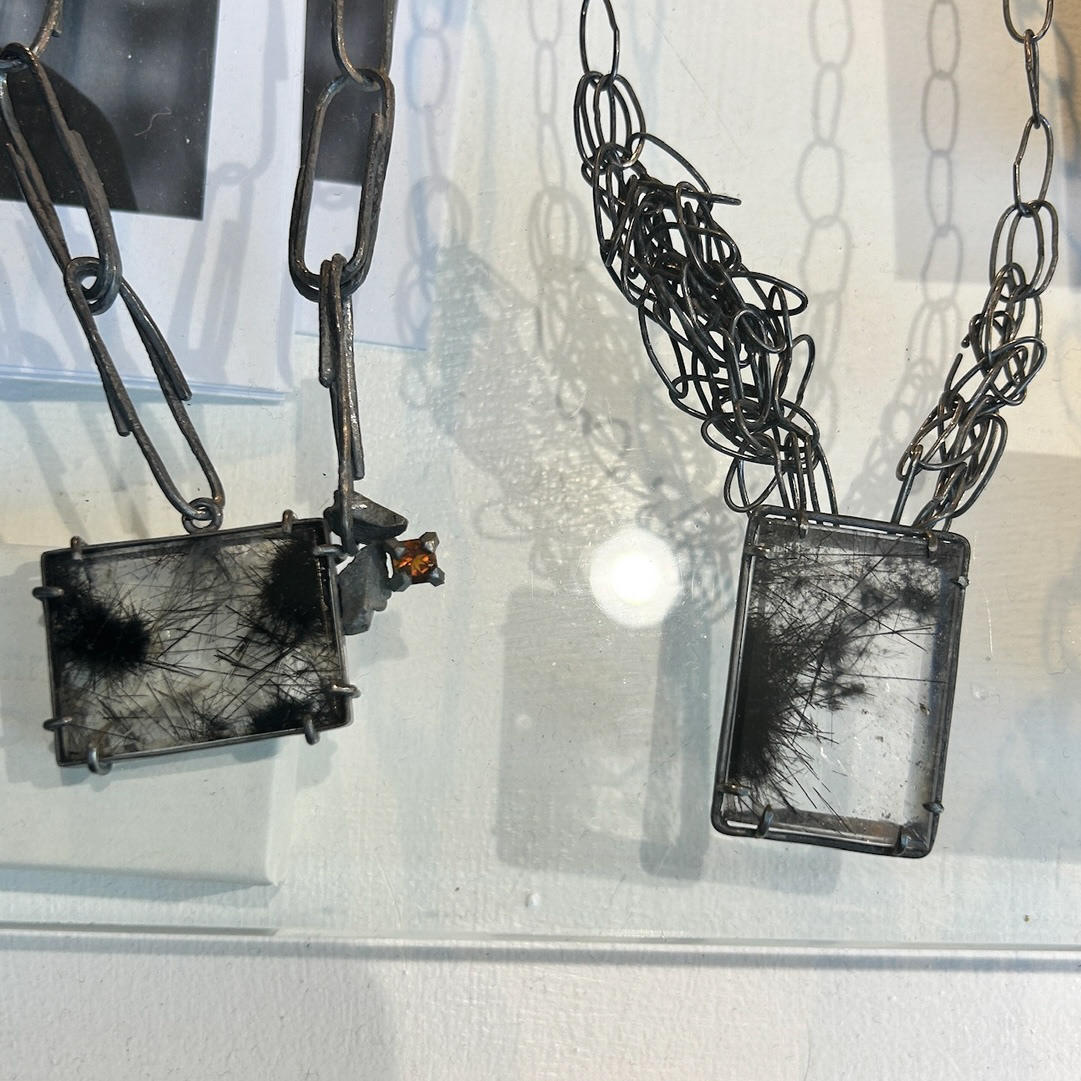
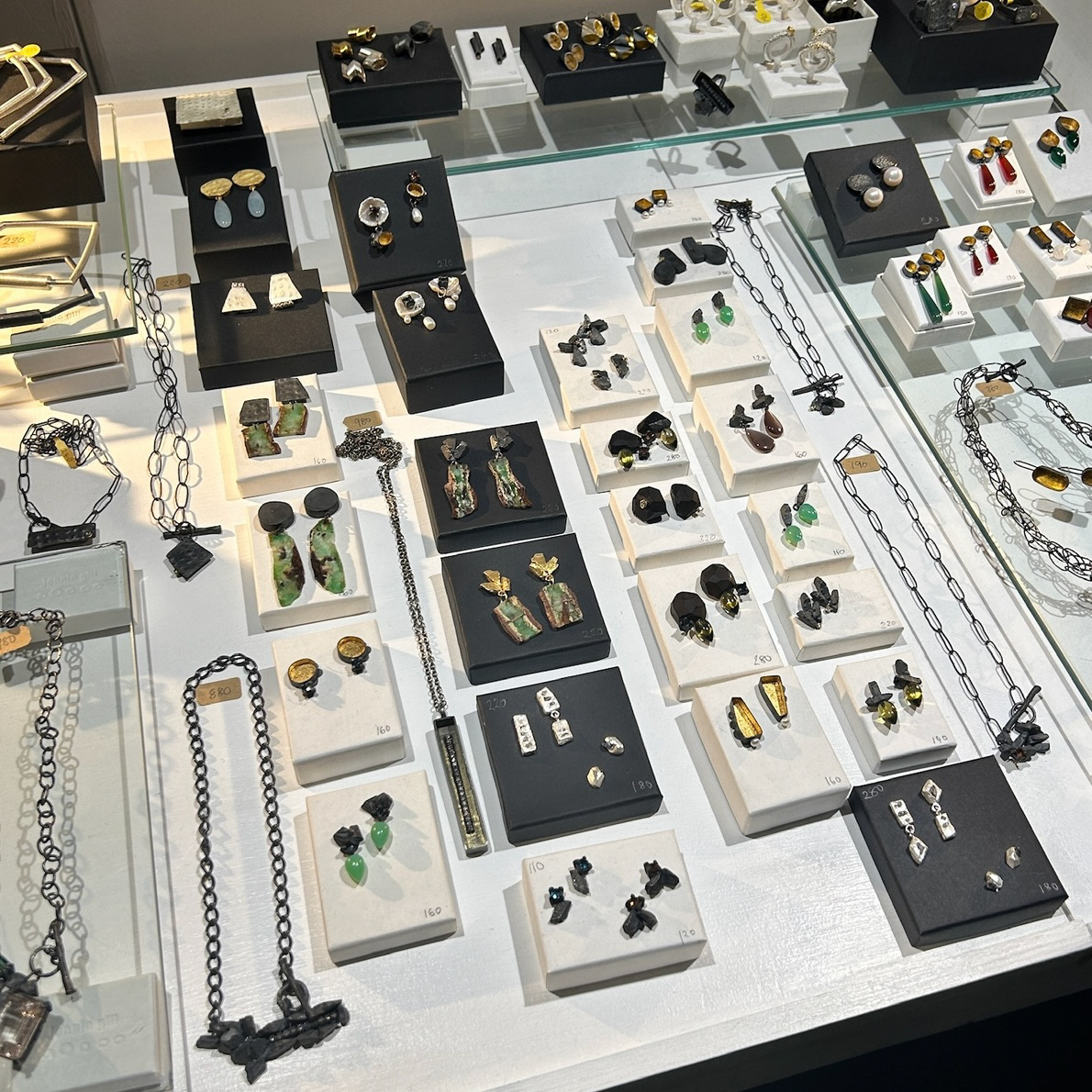
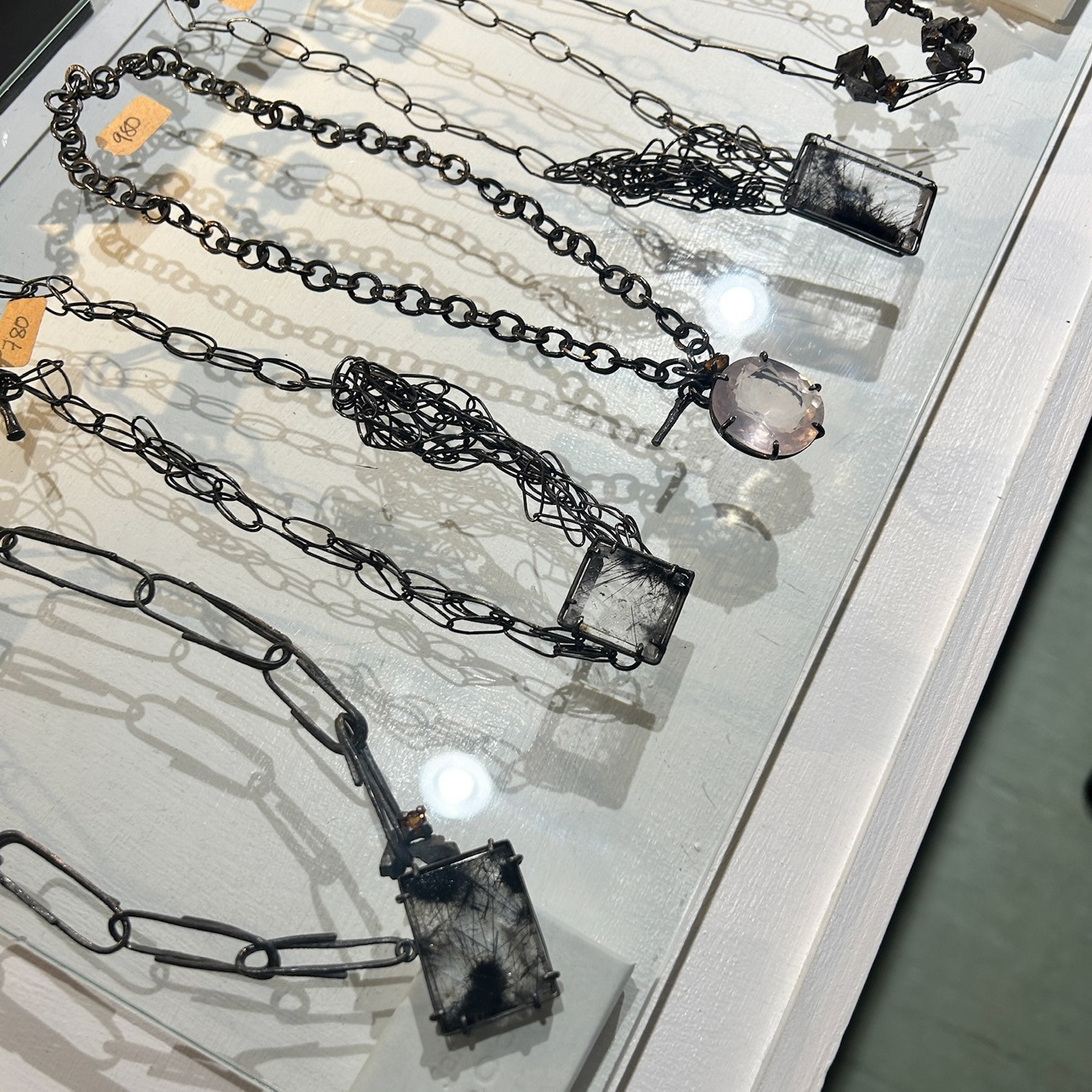
I became inspired by her use of collage-style compositions, as this is something I am planning to utilise in my own work. As well as the use of interesting stones.
I also want to test the idea of using the materials to inspire me. While I do use this to an extent, I often spend hours sitting and designing, to then get very dishearted when aspects do not go the way I want them to. I need to learn to be more experimental and to trust my own instincts, as I feel that this may be holding be back as a maker.

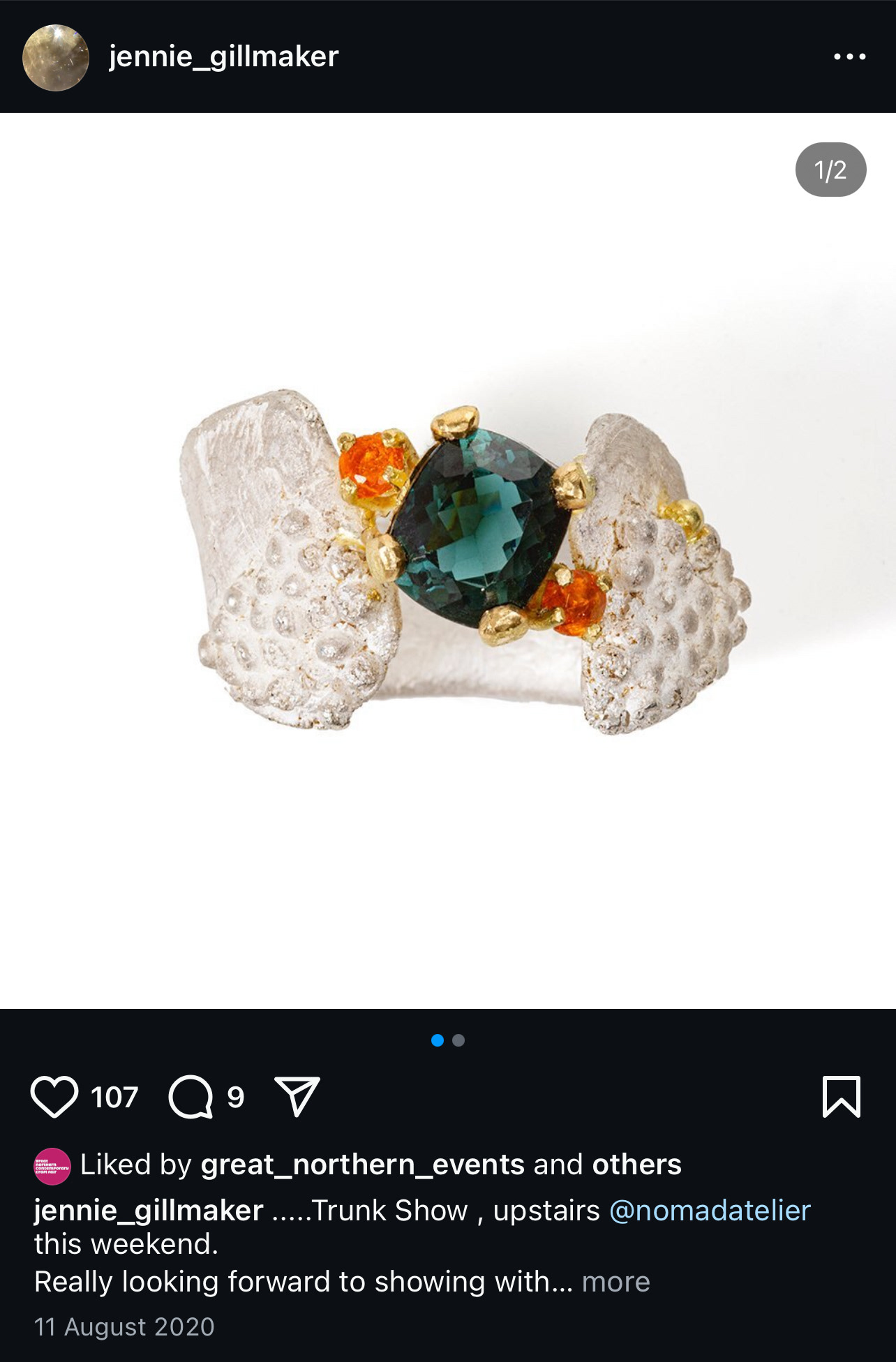
Chris Boland

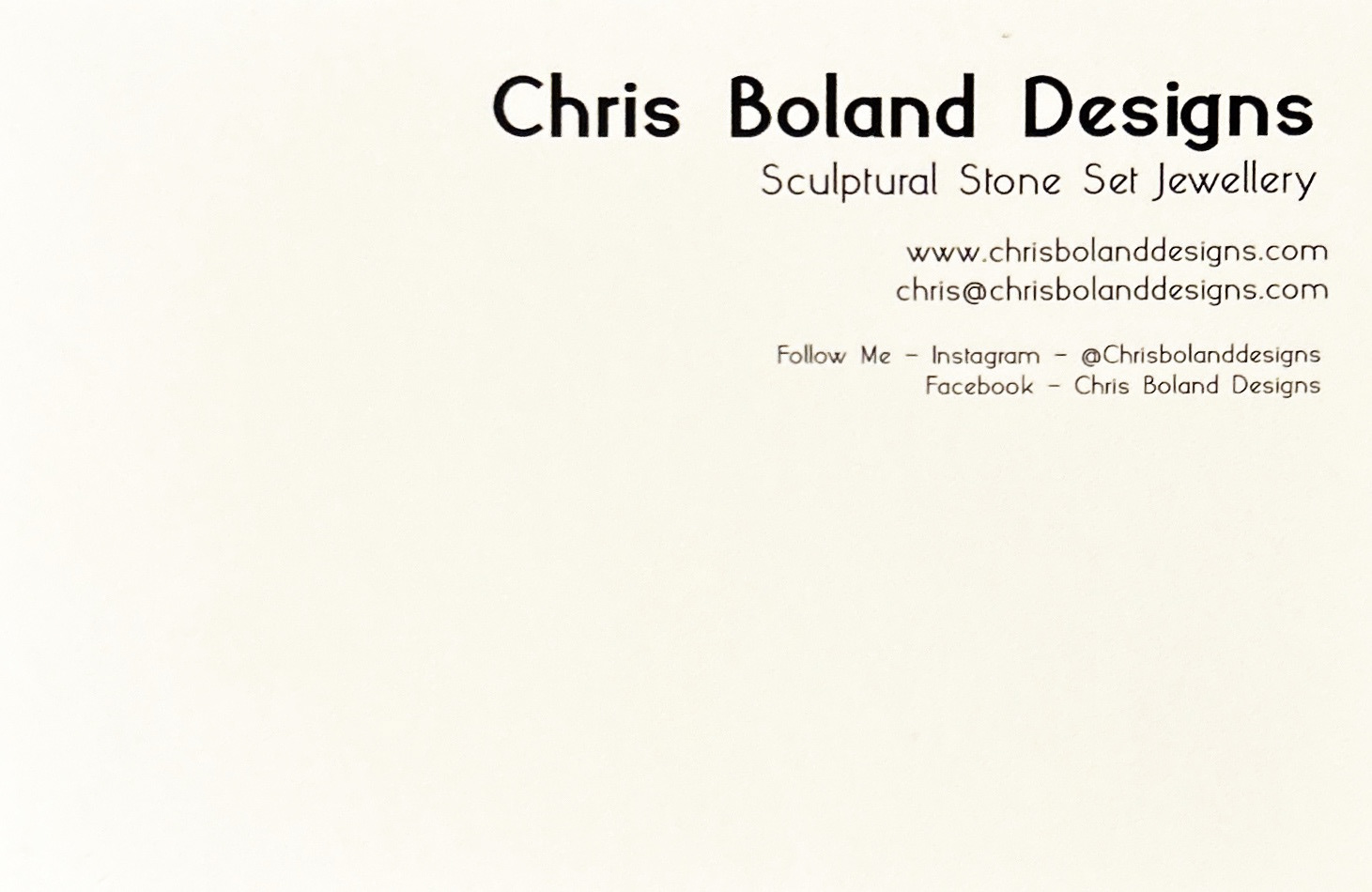

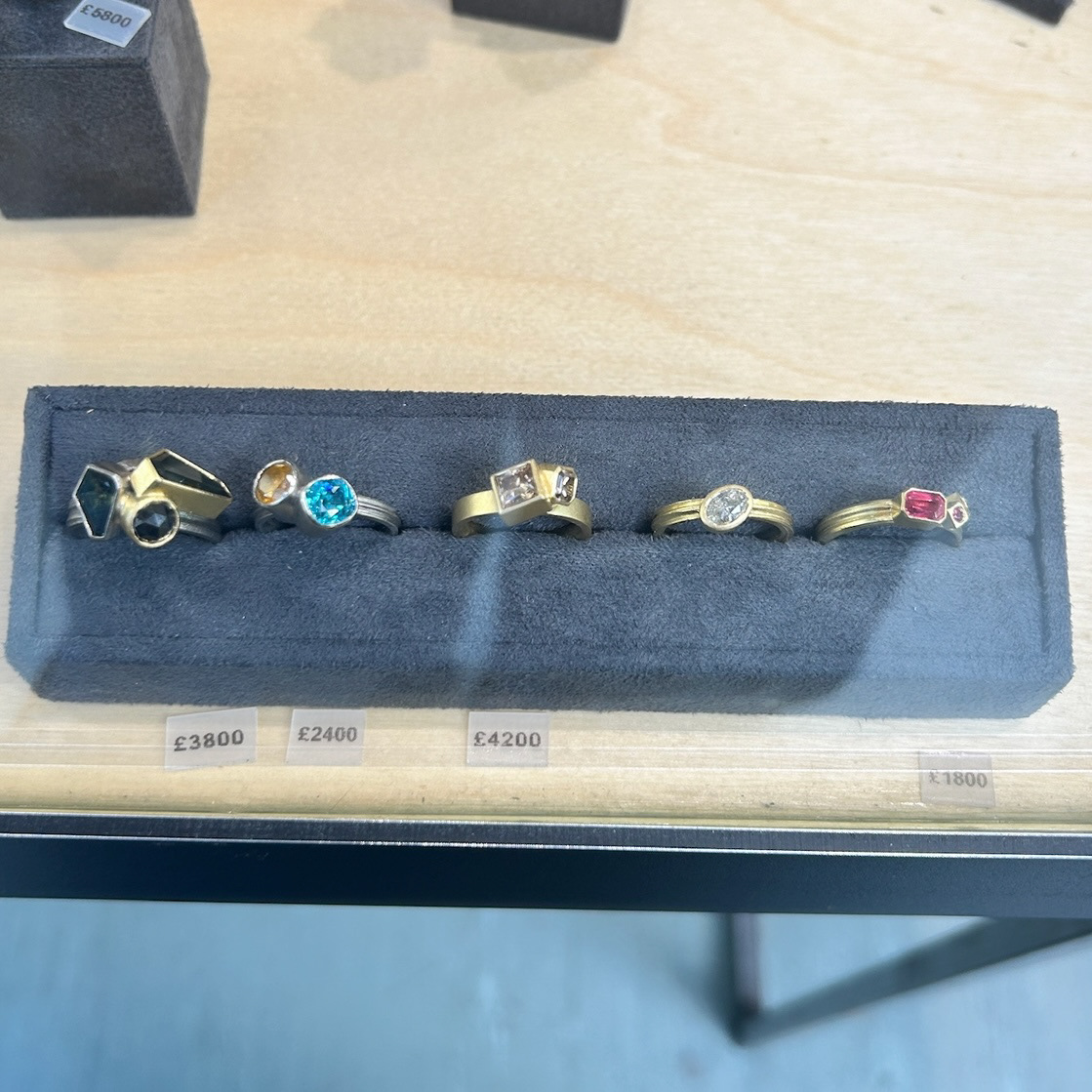
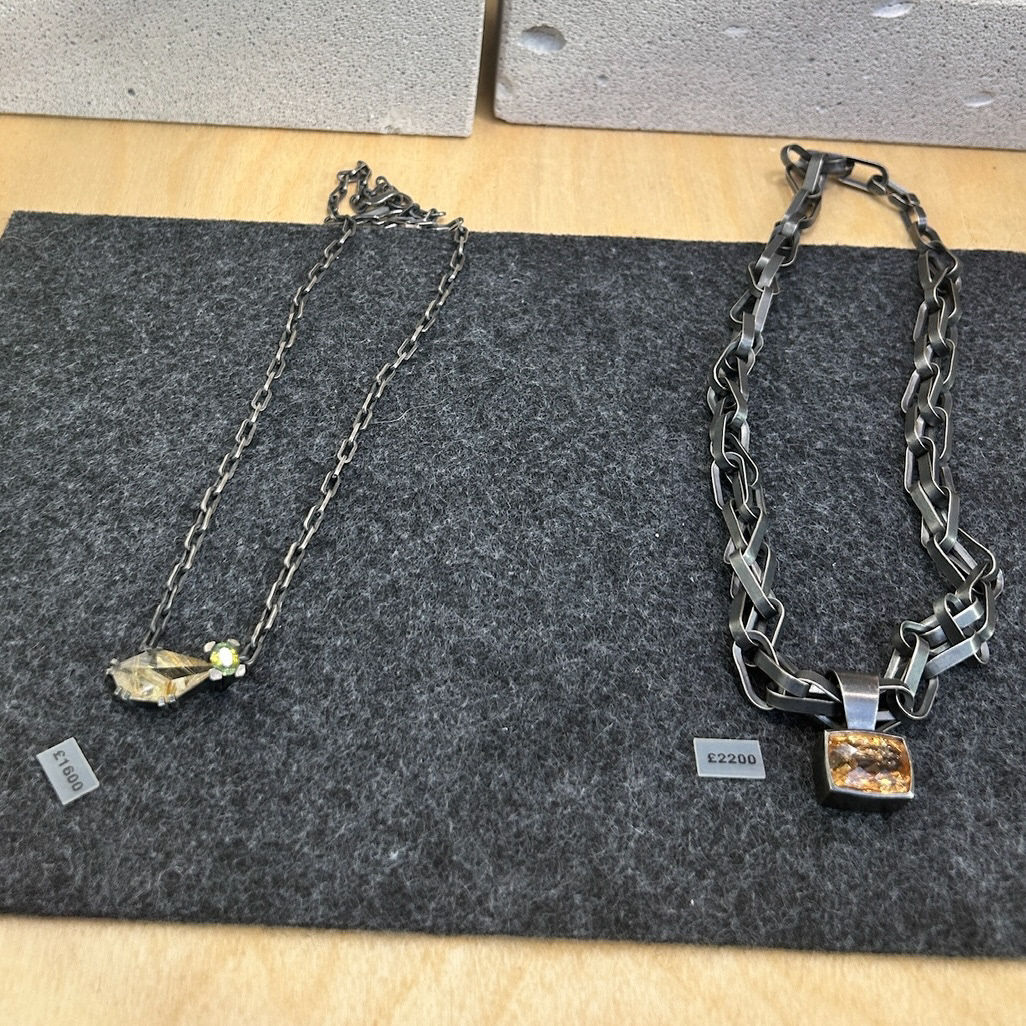
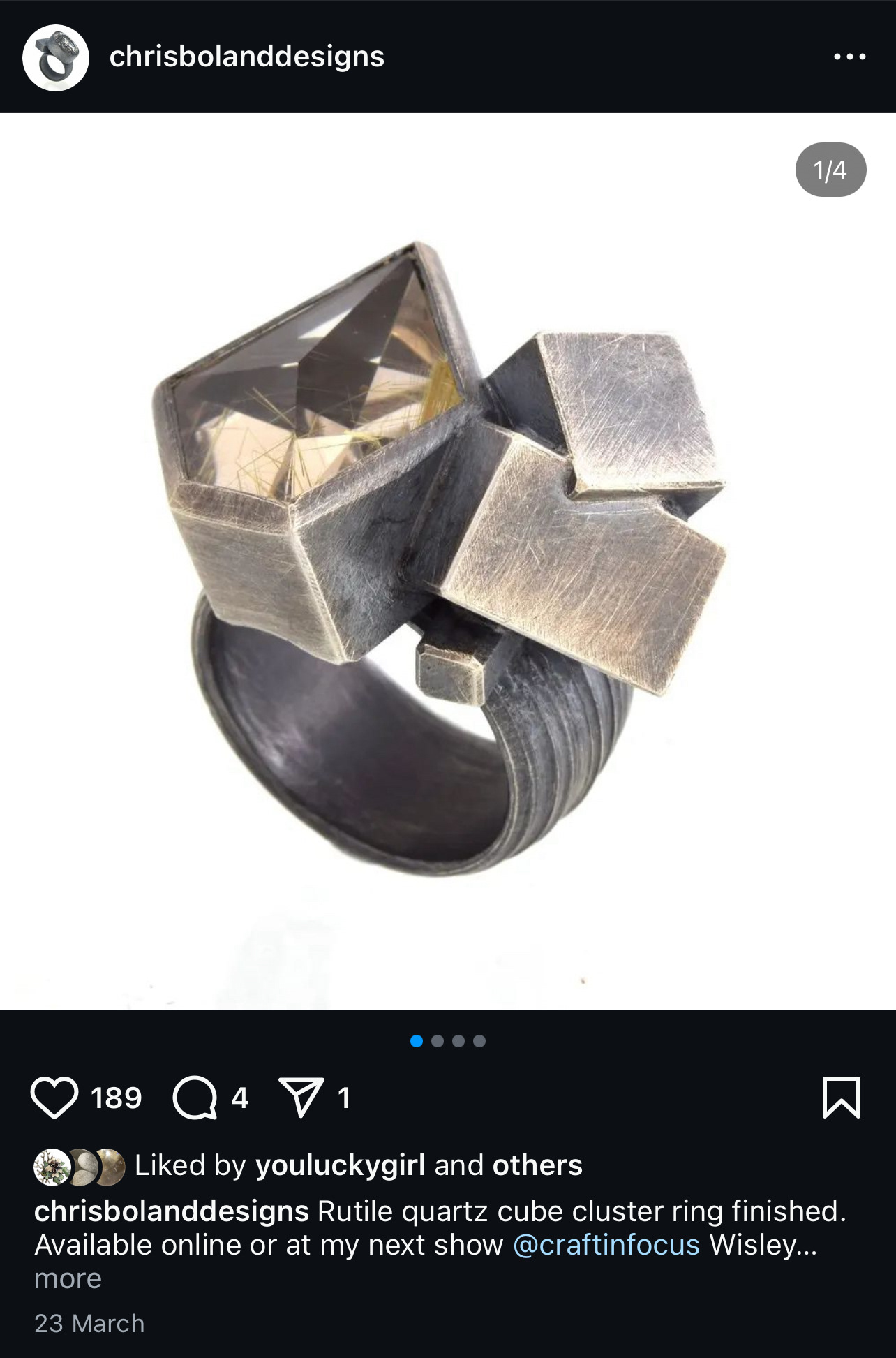
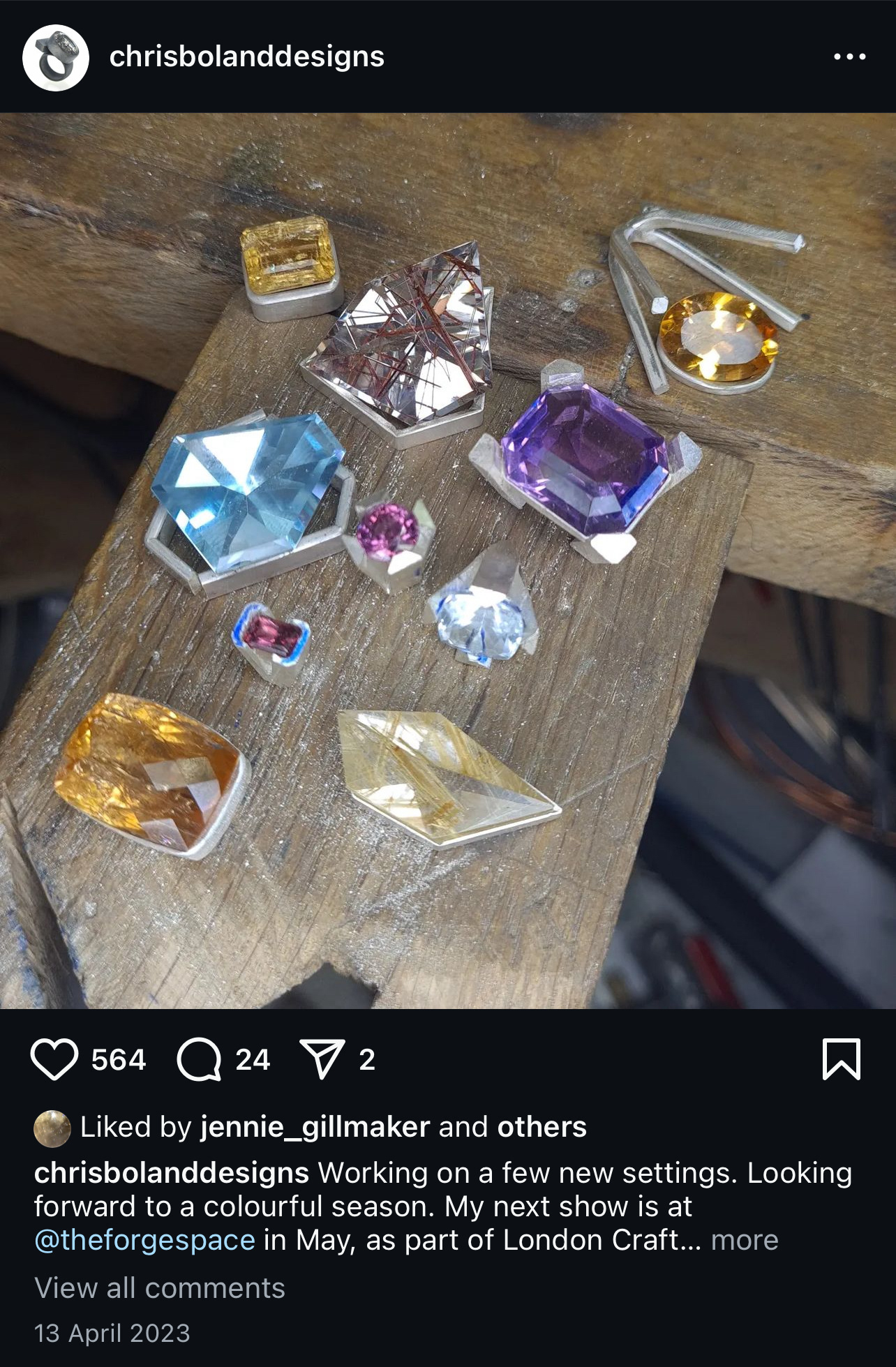
I once again, was inspired by Boland's use of collage in his work, as well as his way of material-based making and use of stone-setting techniques. Boland also explained how he often highlights the marks made during the making process, as this adds texture and allows the wearer to visualise the work that had gone into making his pieces, which is something I often remove during my making process. However, with my idea of using sentimental jewellery that has been worn for generations, this idea of keeping mark-making could hone back to the original artefacts that are covered with these sort of marks.
Birmingham City University
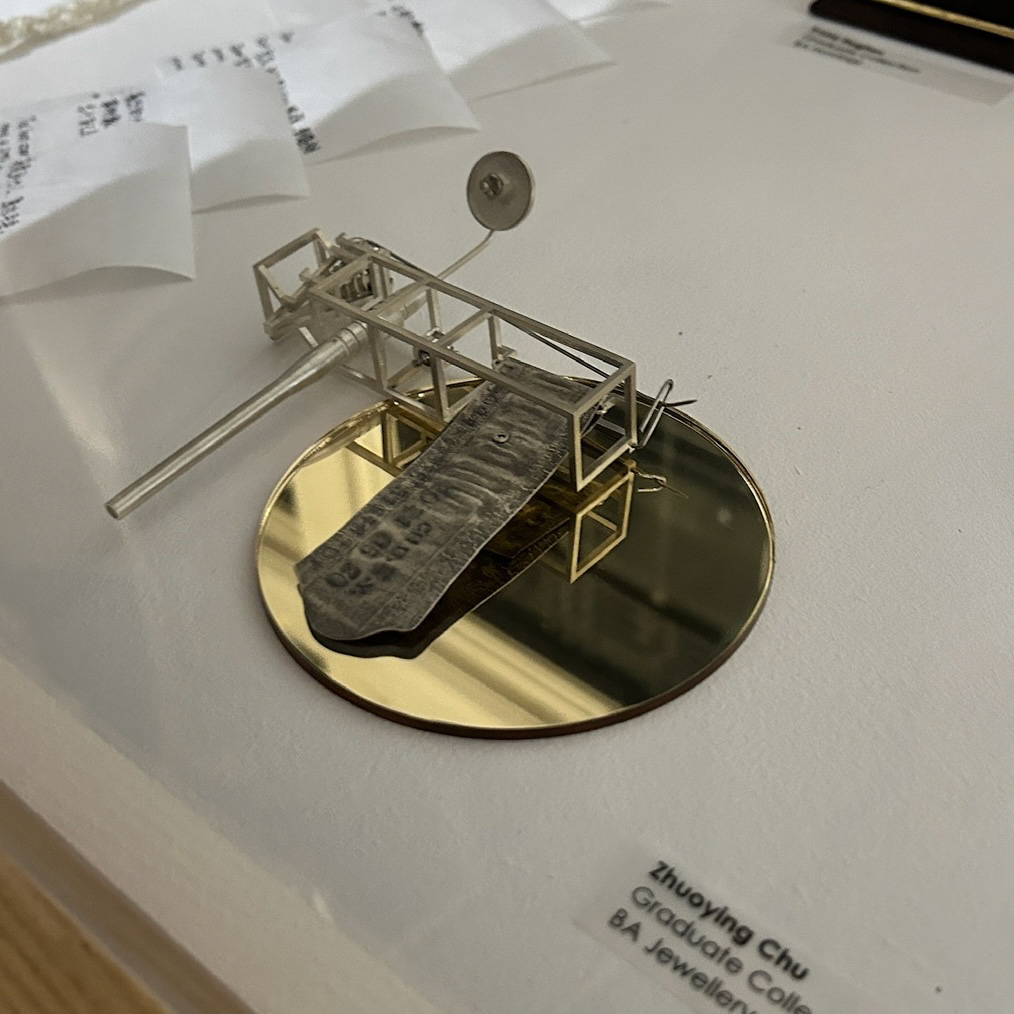
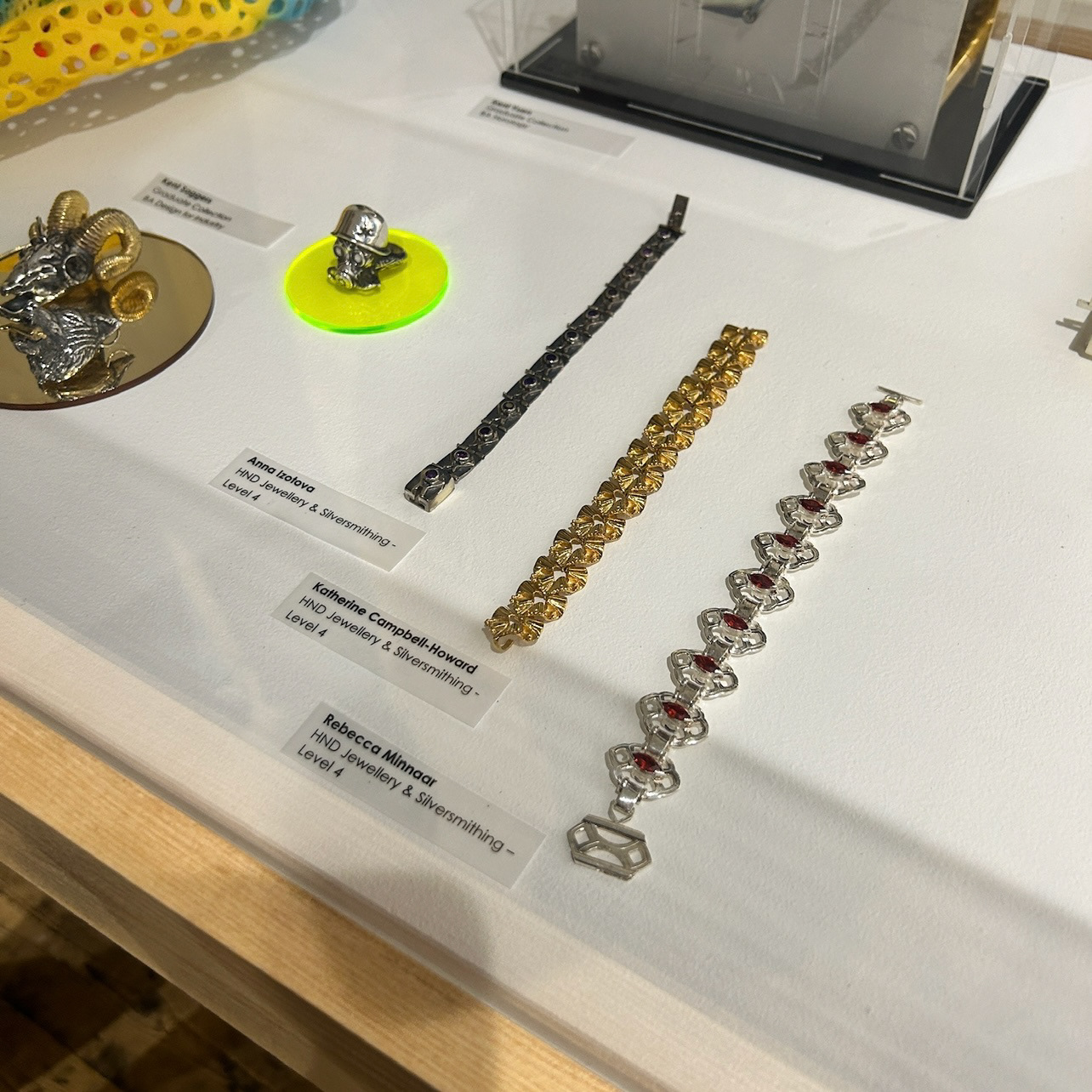
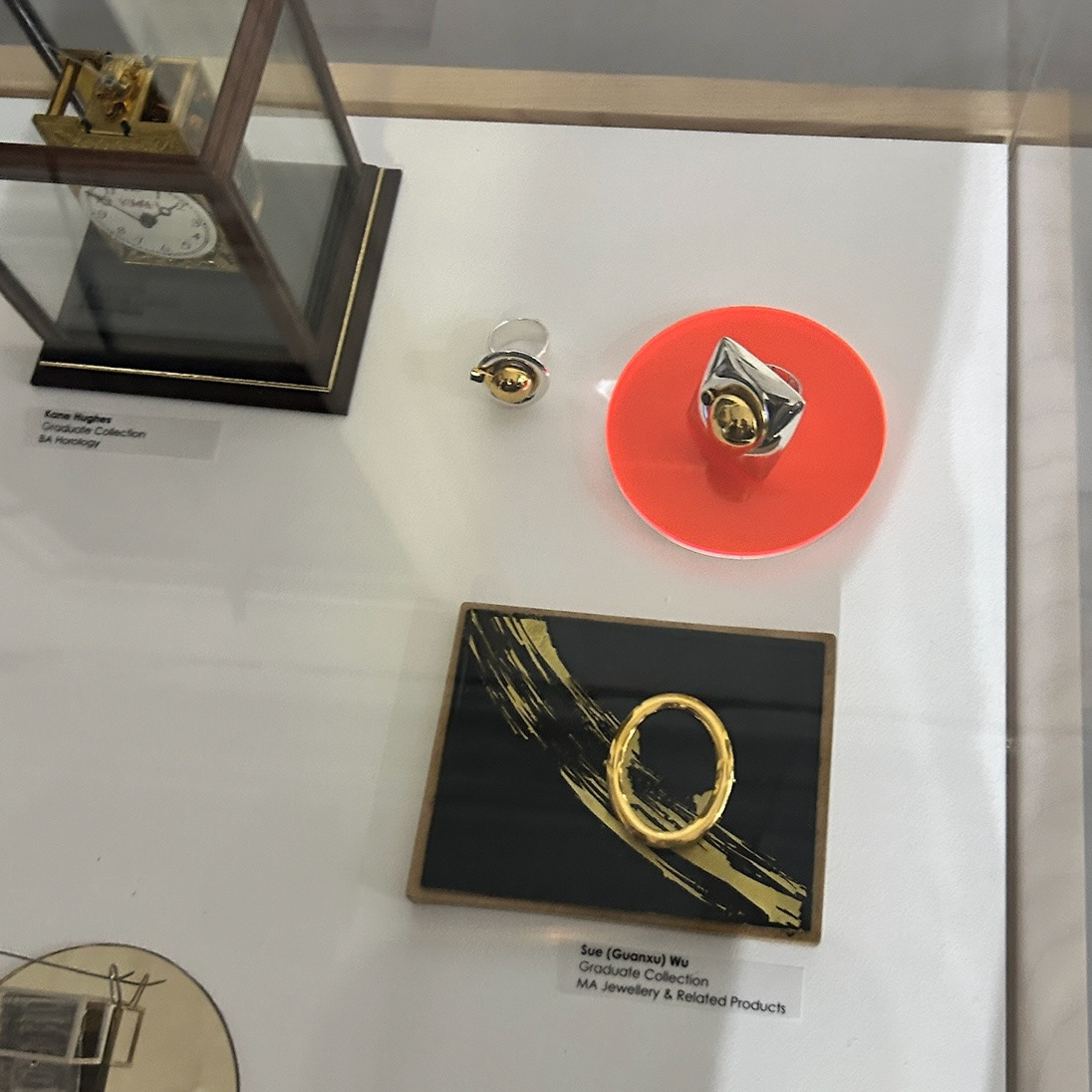
Birmingham City University was in the room next to our stand. Part of their exhibition was showcasing the work of the Jewellery and Silversmithing BA degree. While it was rather humbling to see other degrees' work, I was inspired by the designs, specifically the brooch in picture 1 and the college composition.
I was also inspired by the displays, and how they had used mirrors and bright colours to highlight the work on show.
BCU's work was incredibly refined and all used precise techniques to achieve these amazing pieces. This has given me a drive to become more professional within my practice, and to experiment with CAD.


